Snapdragons—Let’s go!
Plant Profiles dive deep into one specific plant variety, giving you everything you need to make smart, informed growing decisions. Wanting to grow gorgeous flowers is one thing—but figuring out if a plant actually fits you and your climate? That’s a whole different ballgame.
My goal here is to pack in all the practical info you need to make those decisions confidently. But I’m also pulling back the curtain and sharing what’s worked (and what hasn’t) for us in real life. That’s why each Plant Profile is divided into two parts: Nuts & Bolts (N&B) and Behind the Scenes (BTS).
If you haven’t already, be sure to read the FFY Introduction to get the lay of the land and learn more about how these Plant Profiles are organized.
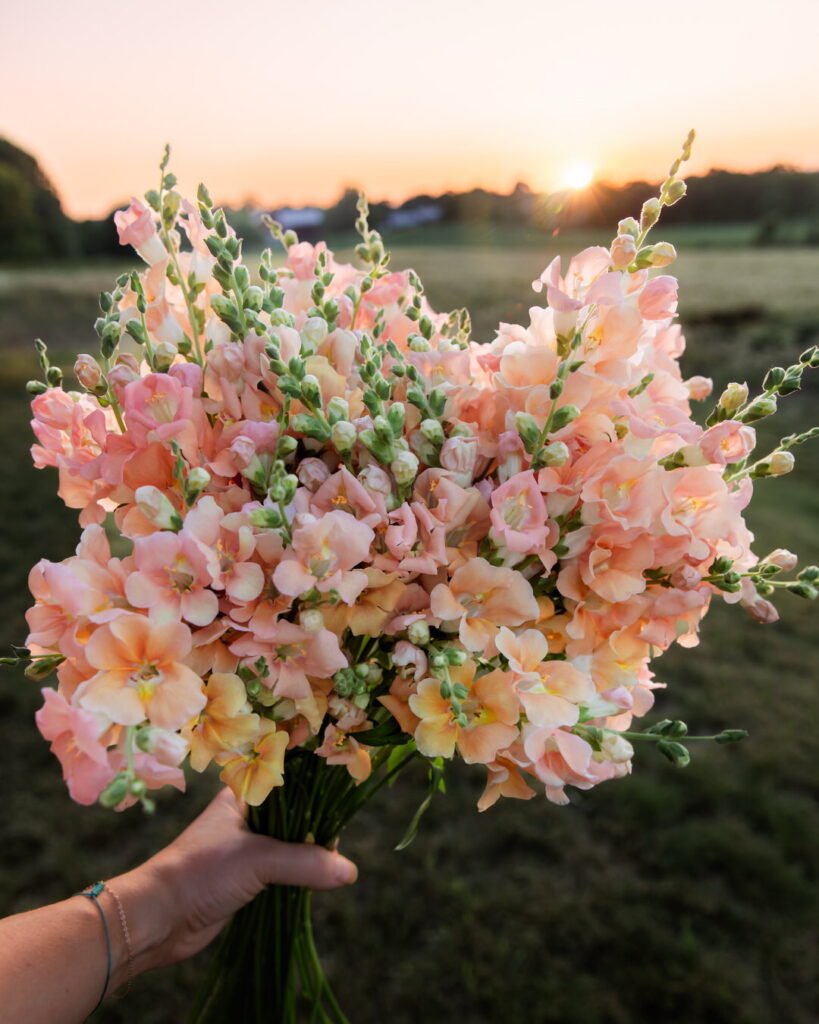
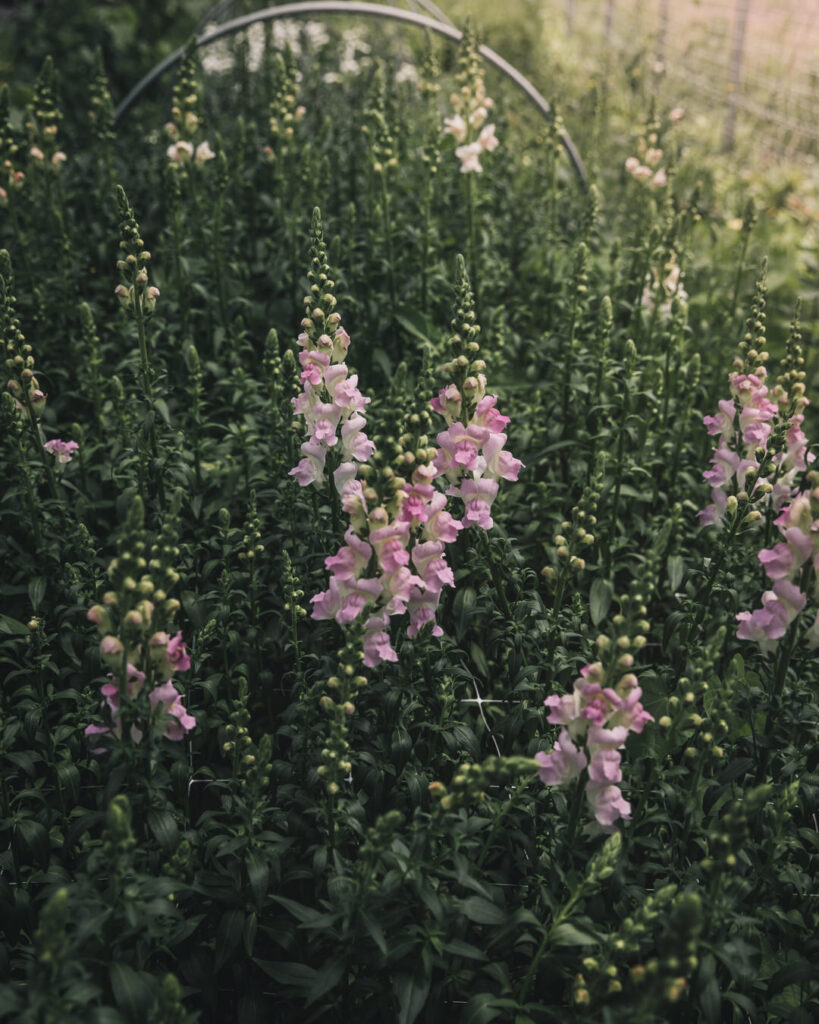
Primary Sources
The primary sources for the N&B portion come from:
- Postharvest Handling of Cut Flowers and Greens: A Practical Guide for Commercial Growers, Wholesalers & Retailers (Dole, Stamps, Carlson, et al).
- Specialty Cut Flowers, 2nd Edition, Revised & Enlarged (SCF): Industry standard for both new and experienced growers on the production of annuals, perennials, bulbs, and woody plants for fresh and dried cut flowers (Allan M. Amritage and Judy M. Laushman)
- Johnny’s Selected Seeds (Johnny’s): Johnny’s has been in the business for 50 years, with a research farm dedicated to finding the best seeds and tools for farmers and gardeners
- BOSTON Ornamental Terminal Prices. Specialty Crops Market News Federal – State Market News Service, USDA (as of 14-FEB-2023
- Farmer Bailey’s website: Bailey Hale is a past Regional Director of the ASCFG, seed-crop producer, plug broker, and a leading farmer-florist expert)
- Lisa Mason Ziegler’s Field & Flower Podcast with David Dowling, Episode 98: Lisa Mason Ziegler is a past Regional Director of the ASCFG, leading farmer-florist expert, author, podcast host, with a vast library of online workshops, while David Dowling is a past Director and President of the ASCFG, with over twenty years flower farming, eventually working for Ednie/Gloeckner
- Snapdragon Cut Flower Production in Utah. Utah State University. Lewis, Stock, Maughan, et. al.
- Improving Snapdragon Cut Flower Production through High Tunnel Season Extension, Transplant Timing, and Cultivar Selection, HortScience horts, 56(10), 1206-1212. Lewis, Stock, Maughan, et. al. Retrieved Apr 18, 2023, from https://doi.org/10.21273/HORTSCI15910-21
Zone Considerations
- Johnny’s Selected Seeds research farm is located in Zone 5a Maine
- Bailey Hale and Thomas McCurdy’s previous farm, Ardelia Farms, is located in Zone 4a Vermont
- Lisa Mason Ziegler’s farm, The Gardener’s Workshop, is located in Zone 7a/8b Virginia
- USU Trials were conducted at Greenville Farms, Zone 5 Utah and USU Botanical Center, Zone 6 Utah
- HortScience references farms Zones 3–8
- My farm, Petal Back Farm, is located in Zone 4b Wisconsin
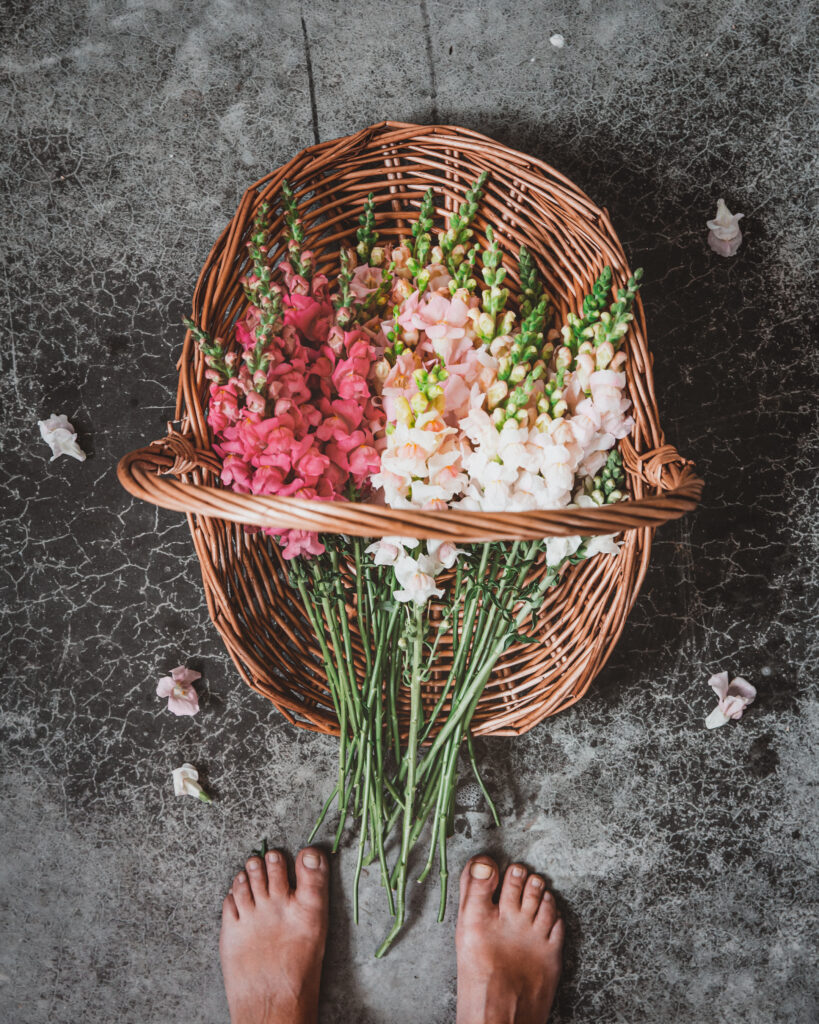
General Information: N&B
- Latin Name Name: Antirrhinum majus
- Common Name: Snapdragon
- Origin: Mediterranean
- Days to Maturity: 105–120 days (variety dependent)
- Life Cycle: Annual
- Spacing: 4–12″
- Height: 12–60″. When grown as a one-cut, stems can be as long as the full height of the plants. When grown for multiple cuts per plant, stems vary in length at 12–36″.
Snapdragons hail from the northern temperate zones, with a strong presence in the Mediterranean region. Their dense flower spikes are lined with tubular or butterfly-shaped blooms in a dazzling array of colors—one reason they’re such a beloved cut flower. Fun fact: they’re also edible!
In most climates, snaps are grown as cool-season annuals, though they can handle heat. In the United States, greenhouse production is common, but they can also be field-grown: in spring in the South and far West, and in summer in northern states (SCF).
Modern breeding has produced varieties tailored for specific growing conditions and harvest windows. Most snapdragons are classified into numbered groups that indicate the season and conditions for which they are bred (Johnny’s). And when it comes to spike flowers, few can match the market demand—or the kaleidoscope of colors—snapdragons offer (SCF).
General Information: BTS
I love, love, love snapdragons! This nostalgic beauty is an absolute must-grow for any farmer-florist. They’re reliable, they bloom abundantly, and they win hearts across the board—florists, wholesalers, and retail customers alike. Bonus: pollinators can’t get enough of them, and they have the sweetest, faintly bubblegum scent.
Why I’m obsessed with snaps as a cut flower:
- Easy to grow
- Excellent vase life
- Long-lasting on the stem
- An incredible range of colors
- Perfect spike flower for design and bouquets
- Universally popular with buyers
- Nostalgic charm
- Soft, subtle fragrance
- Prolific and resilient
- Attracts pollinators
- Edible blooms
- Sells beautifully by the bunch
But… every rose has its thorn (or in this case, every snap has its quirk):
- They’re geotropic, meaning they respond to gravity. If your support netting isn’t strong or you store stems at an angle, they’ll bend—hard. And not in the “cool, artistic curve” kind of way, but more like a crisp 90-degree right turn.
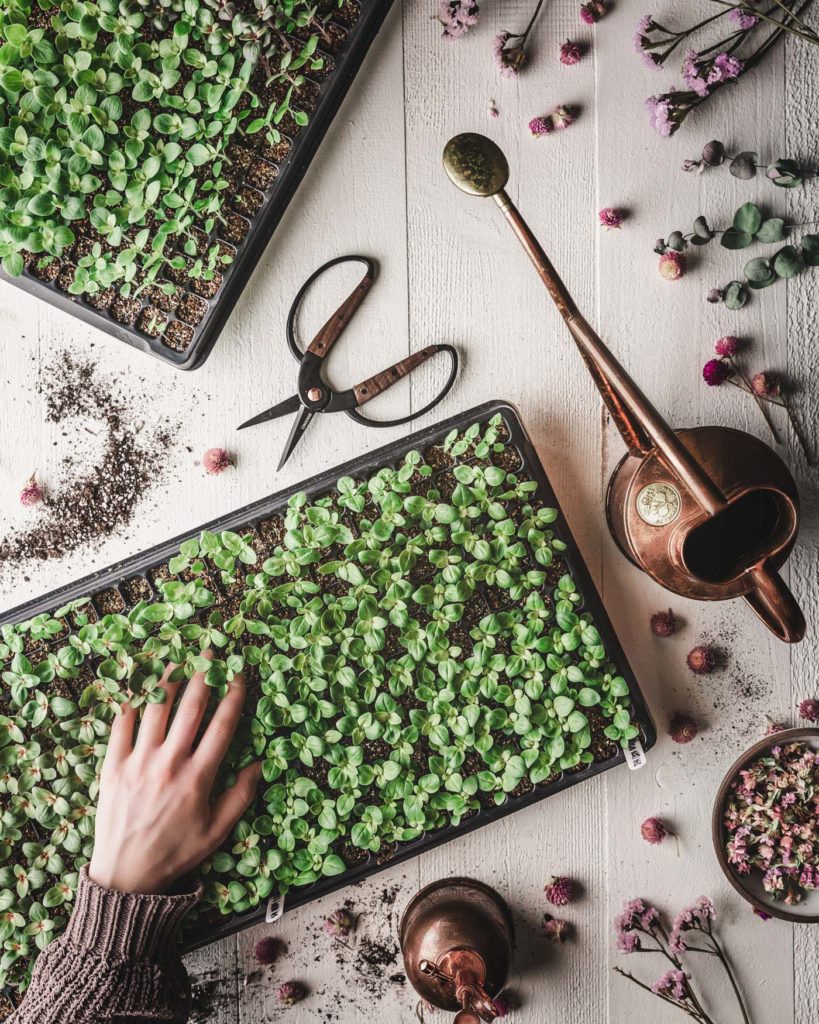
Propagation: N&B
Snapdragons are most often grown from seed, though some growers—like Gemma from Green Rabbit Flowers—have successfully propagated them from cuttings to increase stock. Pre-grown plugs are also an option, and according to Dowling, they’re one of the most affordable plugs available (as little as $0.12 per plant).
Johnny’s recommends sowing seeds in 128-cell trays (or your preferred seedling container) 8–10 weeks before planting out, after the last frost. Light is required for germination, but covering seeds with a fine layer of vermiculite helps retain moisture and reduces algae growth. Bottom-water to avoid splashing soil over the seeds.
Once seedlings emerge, reduce moisture slightly—keeping soil evenly moist but never saturated. Maintain a soil temperature of 65–75°F (18–24°C) during germination. After plants develop 3–5 leaves, SCF recommends holding temperatures close to 60°F (15°C) to avoid tall, spindly growth. Harden off plants before transplanting into the field or greenhouse.
Propagation: BTS
We start all our snaps from seed in 128-cell trays and skip the bumping-up stage—they go straight from tray to field. Honestly? I don’t obsess over hitting the “perfect” temperature range, but our seedlings are typically kept somewhere between 60–70°F. Snapdragons are surprisingly forgiving, and in my experience, they don’t seem to hold grudges if the thermostat isn’t set just right. To avoid spindly growth, we keep the grow lights just a couple inches above the plants.
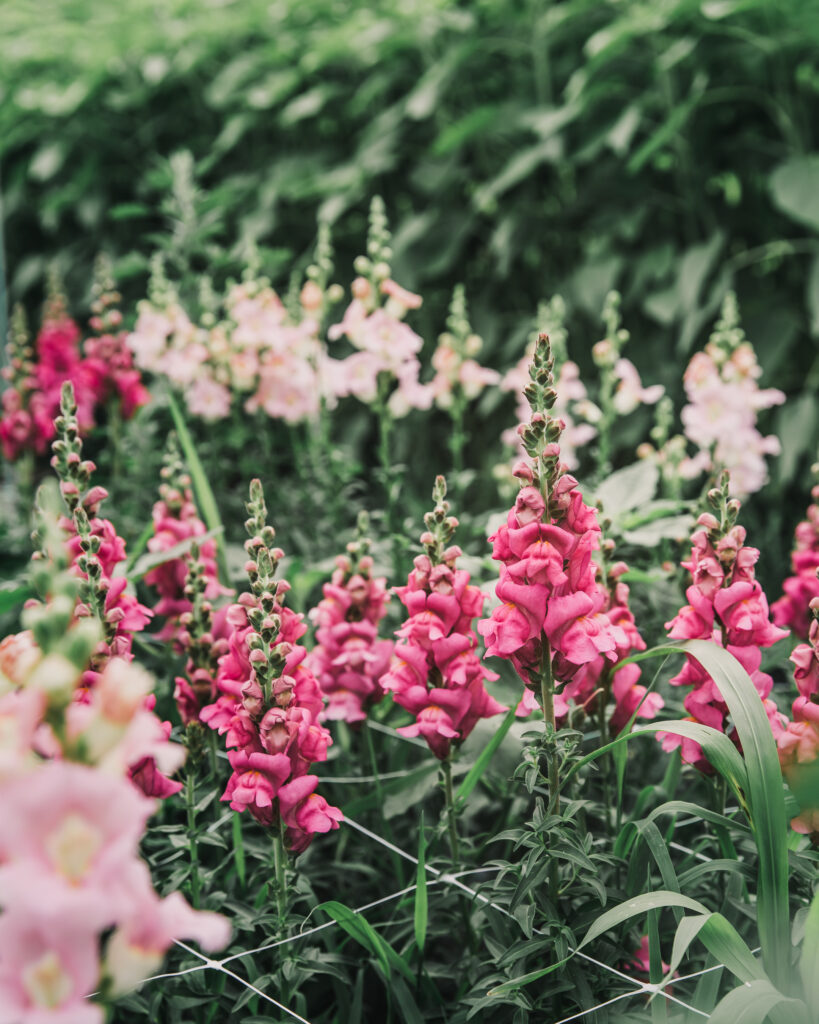
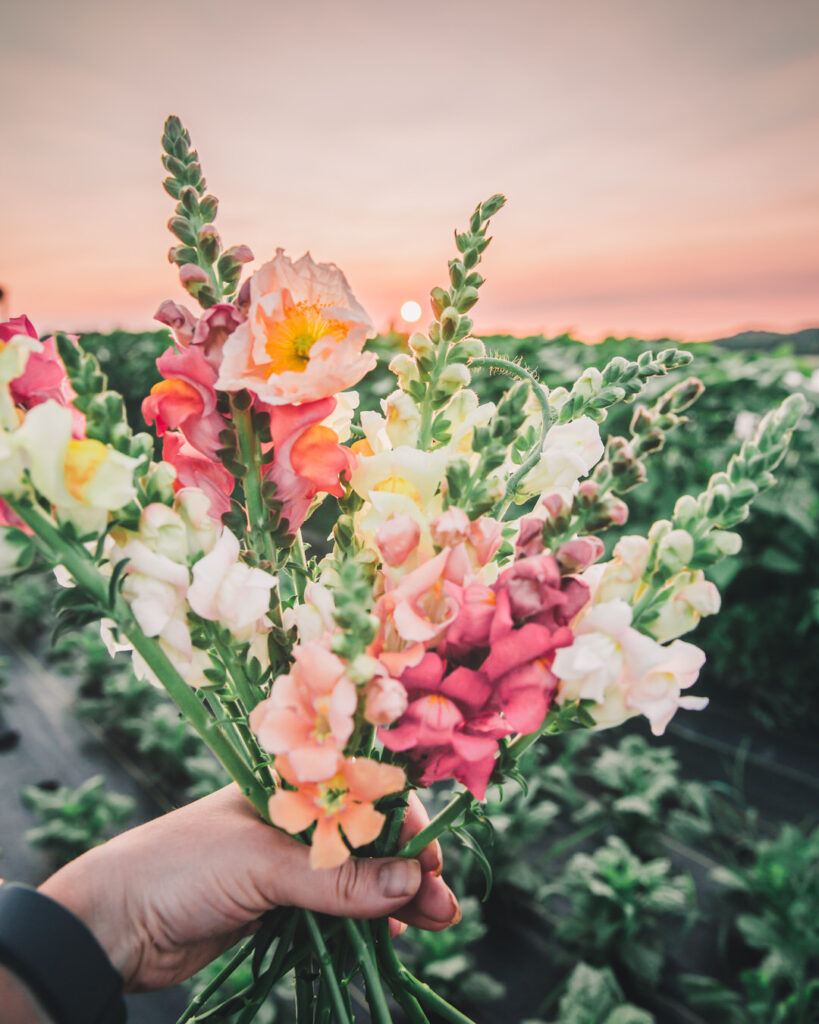
Environmental Factors: N&B
Photoperiod
Many modern greenhouse varieties have been bred to be virtually unaffected by daylength—particularly the late-flowering cultivars (SCF)—or, at the very least, bred for specific seasons (Johnny’s). Most snapdragon varieties are classified into numbered groups based on the growing and harvest periods they’re bred for (more on groups later).
Light intensity
Under high light, snapdragons produce stronger stems, flower more quickly, and yield more blooms. Light intensity is mostly a concern for winter, greenhouse-grown snaps (SCF).
Temperature
While snaps don’t require vernalization, those grown in cooler temperatures (50°F/10°C or below) initiate and open flowers later than those grown warmer. However, warm conditions can reduce spike length and stem strength (SCF).
Site Selection
Snapdragons can be grown either in a protected structure or the open field. Most growers agree that protected production yields higher-quality blooms and longer stems, but snaps can still thrive in the field. In fact, combining both methods can extend and stagger your harvest window.
According to USU: Overall, high tunnels advanced harvest by five weeks and produced 24% more marketable blooms than the field, with stems averaging nine inches longer. Field production, on the other hand, extended the harvest window by four weeks in late July and August.
Snaps prefer rich, well-drained, neutral soil in full sun or partial shade. In fact, USU recommends growing under shade from May through August to cool the environment and encourage longer stems. SCF makes the same recommendation.
Environmental Factors: BTS
We grow our snapdragons both in the field and in our high tunnel. Like most things, they really shine in the tunnel—but our field-grown snaps still hold their own (even with our brutally hot summers). Our tunnel has shade cloth, which helps . . . but let’s be honest, in July it still feels like standing inside a hair dryer.
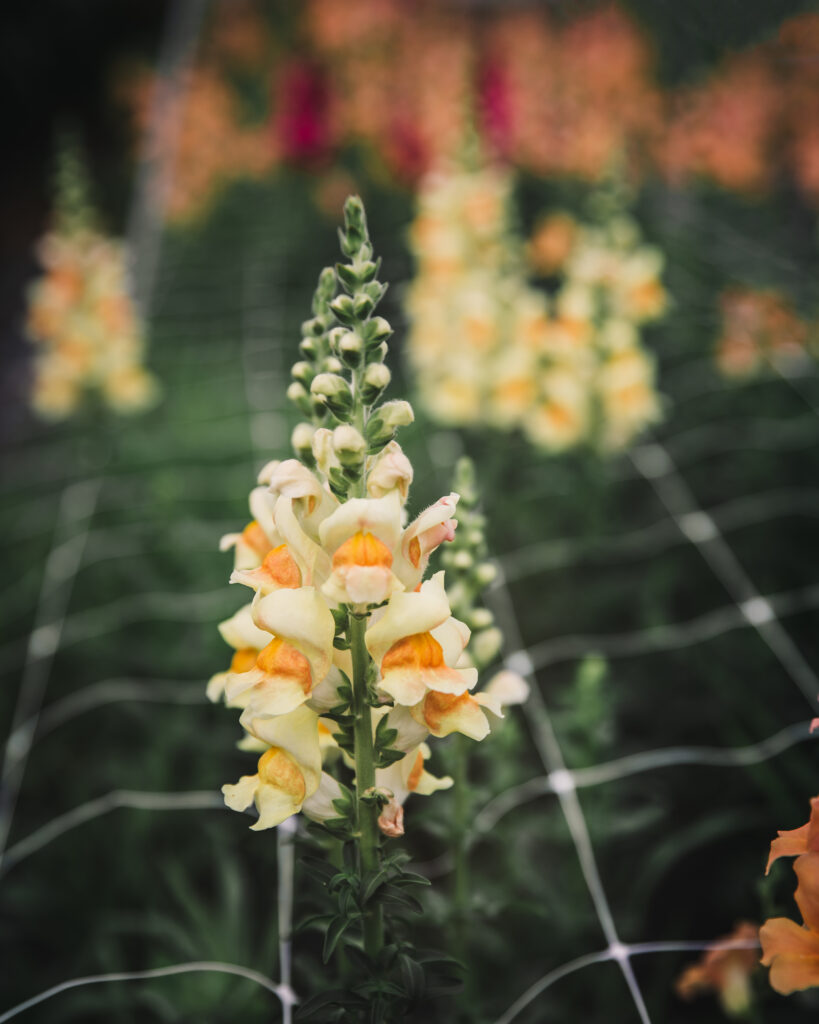

Transplanting, Spacing, Support: N&B
For best results, Johnny’s recommends hardening off snapdragon seedlings by gradually exposing them to outdoor conditions 8–10 weeks after sowing, then transplanting once they’re fully acclimated. The exact timing will depend on your location and growing environment—snaps can be grown year-round in certain climates or with greenhouse production. For continuous harvests, most sources suggest succession planting every three weeks.
Spacing depends on whether you plan to pinch:
- Pinched plants: 6–12″ apart. Pinching removes the central growing tip, encouraging branching and producing more stems overall, but those stems can be thinner.
- Non-pinched plants: 4″ apart. Without pinching, you’ll get fewer stems per plant, but the stems are typically thicker and sturdier—better for premium cut quality.
Dowling and Farmer Bailey recommend planting 2–3 seedlings per hole, spaced 6″ apart, for non-pinched production.
Relevant findings from USU: Pinched plants at 9″ spacing were the most economical and produced higher yields. By contrast, 4″ spacing with non-pinched plants nearly doubled labor, seed, and supply costs—while producing fewer stems per square foot.
All sources agree: use one or two layers of support netting to keep stems straight and market-ready.
Transplanting, Spacing, Support: BTS
Snaps definitely need to be hardened off—those little babies can be sensitive. But once established, they’re surprisingly tough.
For years, I followed the standard advice: space at 9″, pinch most plants, and aim for maximum yield. Pinching encourages branching, which means more stems—but sometimes those stems are thinner. With dahlias, that’s great. With snaps? Not so much.
In 2021, I noticed my pinched Chantillys had thinner, weaker stems. It was a “duh” moment, but I’d just assumed snaps were one of those “you always pinch” crops.
A few seasons ago, I stopped pinching altogether and started planting closer to make up for the reduced stem count. The result? More premium-quality snap stems.
Now, I plant 2–3 seedlings per hole at 6″ spacing, a tip I first picked up from Sunny Meadows Flower Farm’s high tunnel course (though Dowling and Bailey also both recommend this). I worried close spacing might weaken the plants, but it works like a charm for us.
And yes—always, alwaysalways use a layer of support netting. Your future self will thank you.
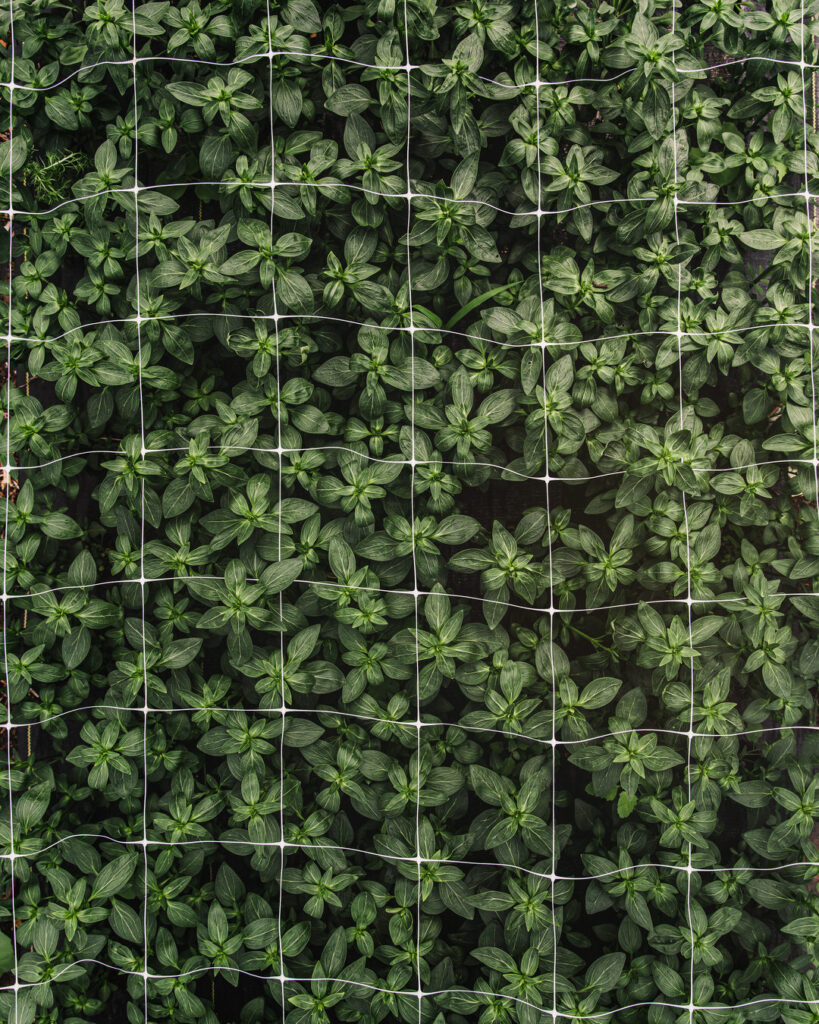
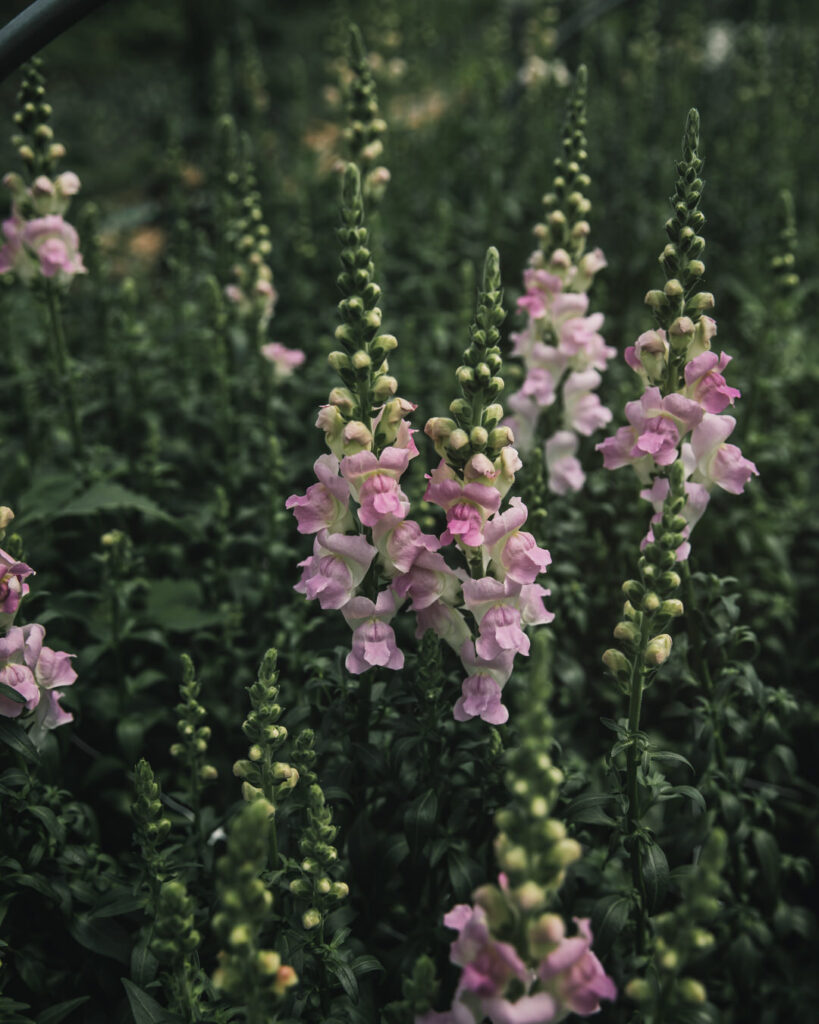
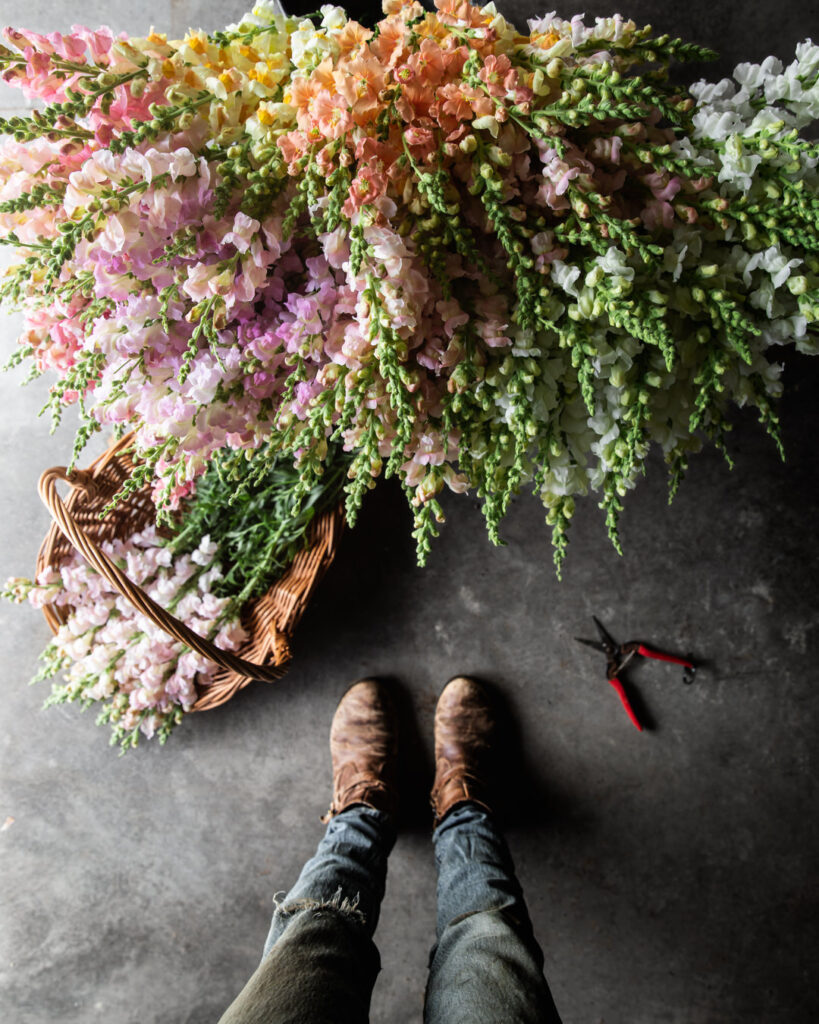
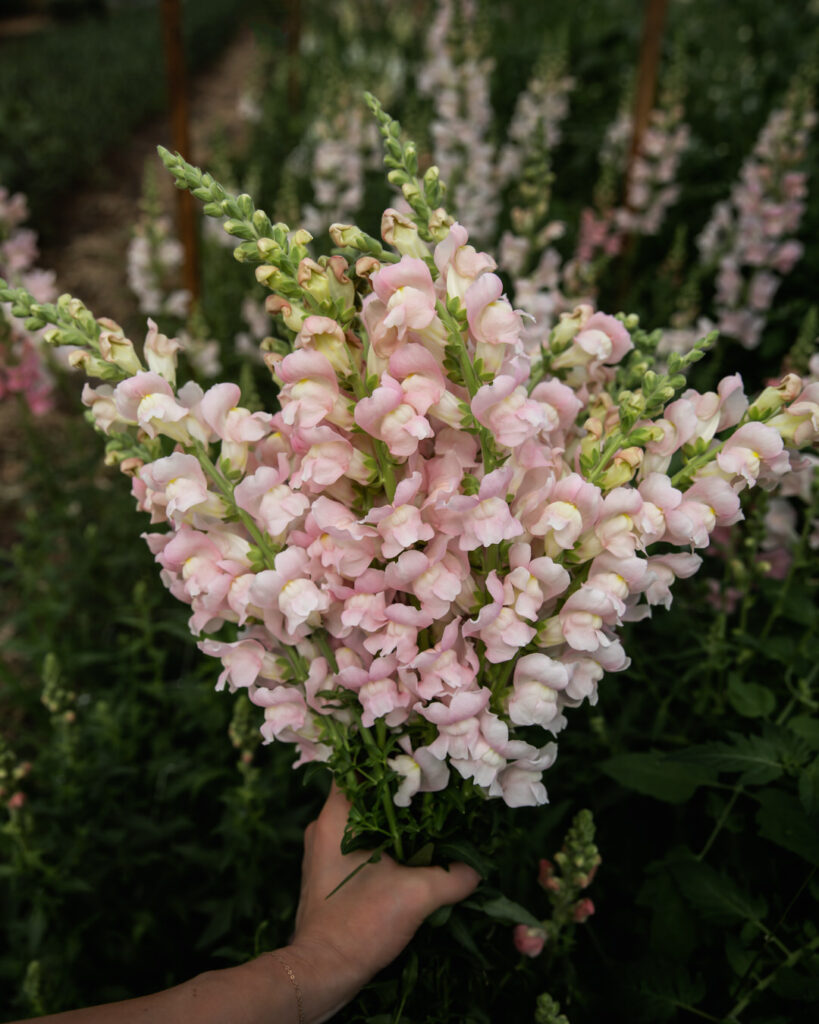
Successions & Groups: N&B
Most sources recommend sowing and succession planting every three weeks for continuous harvest. As mentioned earlier, snapdragon varieties are classified into numbered groups based on their blooming response to light and temperature.
According to USU, groups range from 1–4:
- Groups 1–2 bloom earliest, thriving in lower light and cooler temperatures
- Groups 3–4 bloom later, favoring higher light levels and warmer temperatures
Dowling’s seasonal recommendation:
- Group 1 → Winter & early spring
- Group 2 → Spring
- Group 3 → Late spring & early summer
- Group 4 → Summer & early fall
- Group 3 and 2 again → Fall
He warns: never plant a Group 1 variety (like the Maryland series) for summer—they’ll simply refuse to bloom.
Johnny’s advises, “Plantings should be scheduled according to season, variety, and group to ensure maximum stem length and bloom quality for your climate and growing season.” They provide the following table of recommendations:
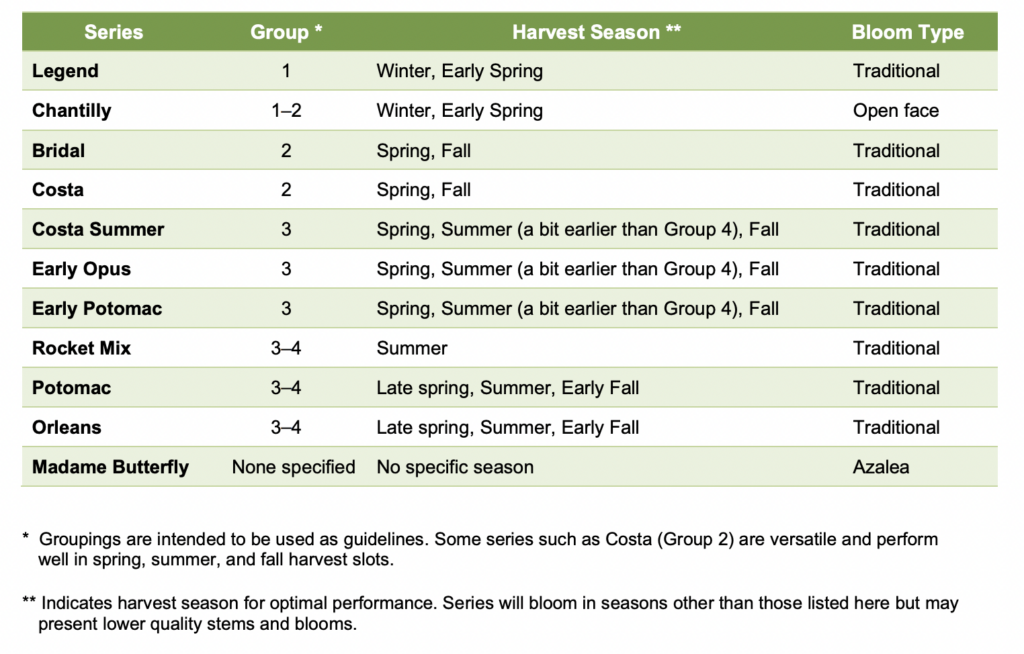

Most sources note that while groups overlap and many varieties will produce usable stems outside their assigned group, doing so often means sacrificing stem length and bloom quality. Though, some series such as Costa/Avignon perform well in spring, summer, and fall.
Key findings from USU trials in Zone 5, Utah:
- High Tunnel → For maximum yield and an extended harvest, optimal planting times are the first and last weeks of March. February plantings are possible for Groups 1–2 (e.g., ‘Chantilly’), but Groups 3–4 should wait until March for better light and temperature conditions. Planting after March isn’t recommended—later plantings produced 7–17 fewer marketable stems than March plantings.
- Field → Best planting window is late April to mid-May. Late May plantings can extend the harvest, but high heat usually reduces quality and yield.
Zone 8 trial (HortScience): No significant yield or stem length difference was found between ‘Potomac Red’ planted in early March vs. mid-April in a high tunnel.
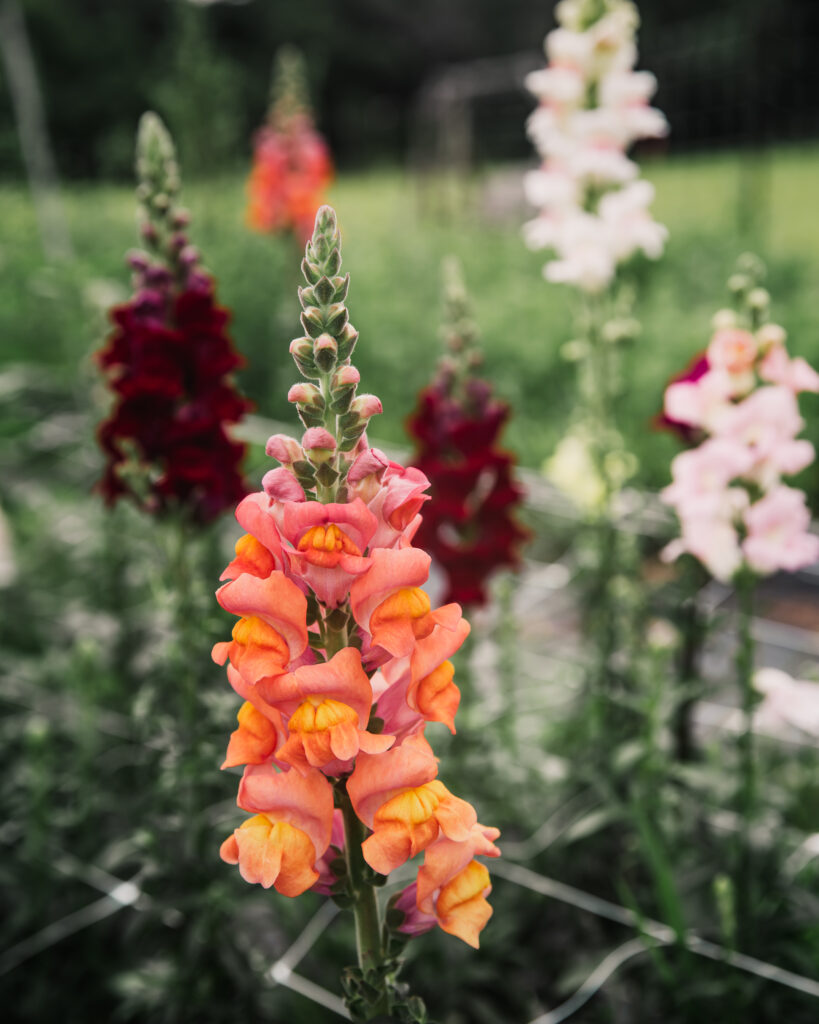
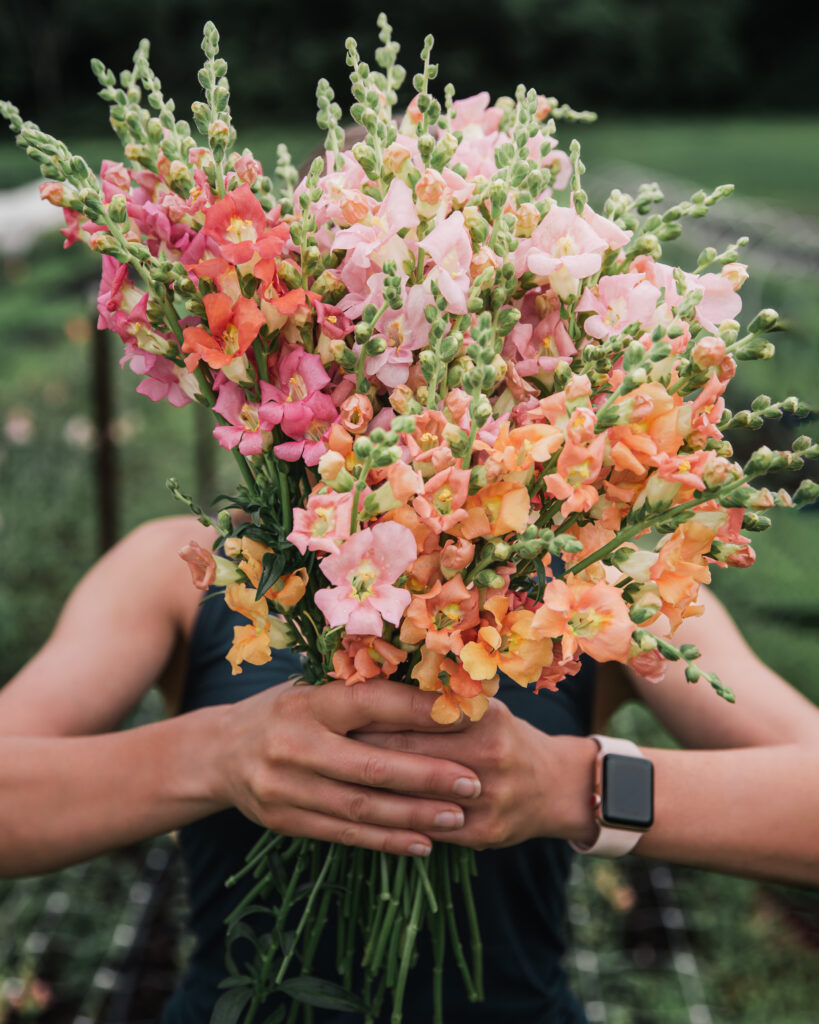
Successions & Groups: BTS
While I keep an eye on group classifications when planning, I’ll be honest—I’ve found that most varieties will flower well regardless of their official group, especially if they’re otherwise happy.
Here’s my usual plan (p.s., remember you have access to my entire Seed Sowing and Transplant plan here):
- Groups 1 & 2 → Sow seeds indoors in January for March/April transplant in the high tunnel, or start seeds indoors in February for April/May field planting.
- Follow with Groups 2 & 3 a couple weeks later.
- Follow with Groups 3 & 4 a couple weeks later.
- Follow with Groups 2 & 3 a couple weeks later.
That’s the plan, anyway. In reality, some years I fall behind and end up transplanting my Group 1/2 snaps much later than “recommended” . . . and they still perform beautifully. At least good enough for me.
Case in point: Dowling warns that Maryland won’t produce in summer. But one year, I planted ‘Maryland Rose’ in the field in late spring—right before our early summer heat—and it did just fine. Honestly, I picked it purely because I liked the color. I’ve had similar luck with the Avignon/Costa series (Group 2) blooming happily in June/July despite their grouping (Johnny’s also confirms this).
Overwintered successions are also fair game—at least with some protection. They’re always part of my plan (unfortunately, summer chaos often wins). For overwintering, my ideal plan is to sow in August, transplant in October, and enjoy an early spring harvest the following year.
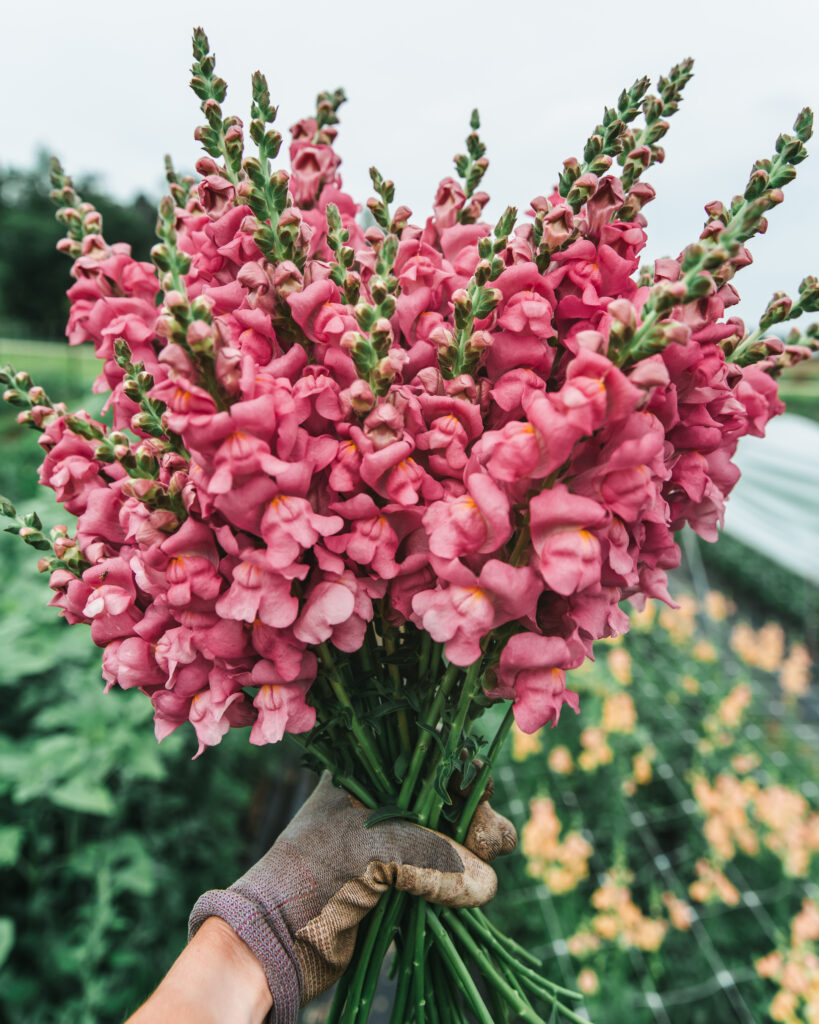
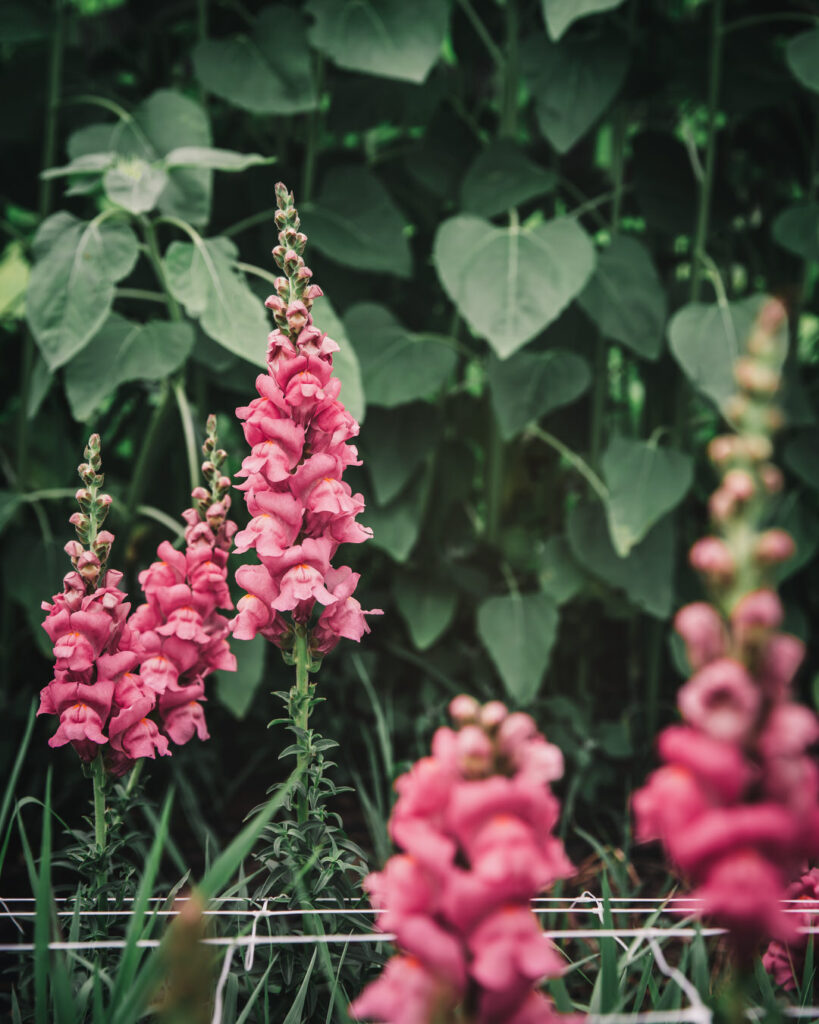
Nutrition: N&B
Snapdragons have moderate nutrient needs. USU recommends applying 0.15 pounds of nitrogen per 100 square feet annually. Phosphorus and potassium should be added before or at planting—but only according to soil test results, since both nutrients can accumulate in the soil over time. Dowling and SCF recommend a balanced, general-purpose fertilizer, noting that regular feeding benefits plant health and stem quality.
Nutrition: BTS
While I’m sure that dialing in your fertilization game for each individual crop is the gold standard, that’s not how we roll. We fertilize our fields organically based on soil test results, rather than tailoring a custom program for each flower (though I might sneak a little extra nitrogen to my sweet corn, because, well, sweet corn).
If you want the nitty-gritty details on how we manage fertility across the farm—without overcomplicating it—I’ve laid it all out in my eBook, which you can find here.
Drainage & Irrigation: N&B
Most sources recommend drip irrigation for snapdragons. Overhead watering can be used, but it increases the risk of disease. If you do use overhead, water early in the day so foliage has time to dry before nightfall.
According to USU, snapdragons need a consistent supply of water for maximum growth. They recommend applying 1–2 inches of water per week, adjusting for temperature, growth stage, and soil texture.
Drainage & Irrigation: BTS
At our farm, we’ve got gossil-loamy sand—which is just a fancy way of saying “more sand than loam.” And while that sounds beachy and fun, it means our soil drains fast—like, blink-and-your-nutrients-are-gone fast.
Because of that, supplemental irrigation is non-negotiable, especially during dry spells. We run drip irrigation on all our beds at the home farm, and it’s a lifesaver for keeping our snaps happy and hydrated.
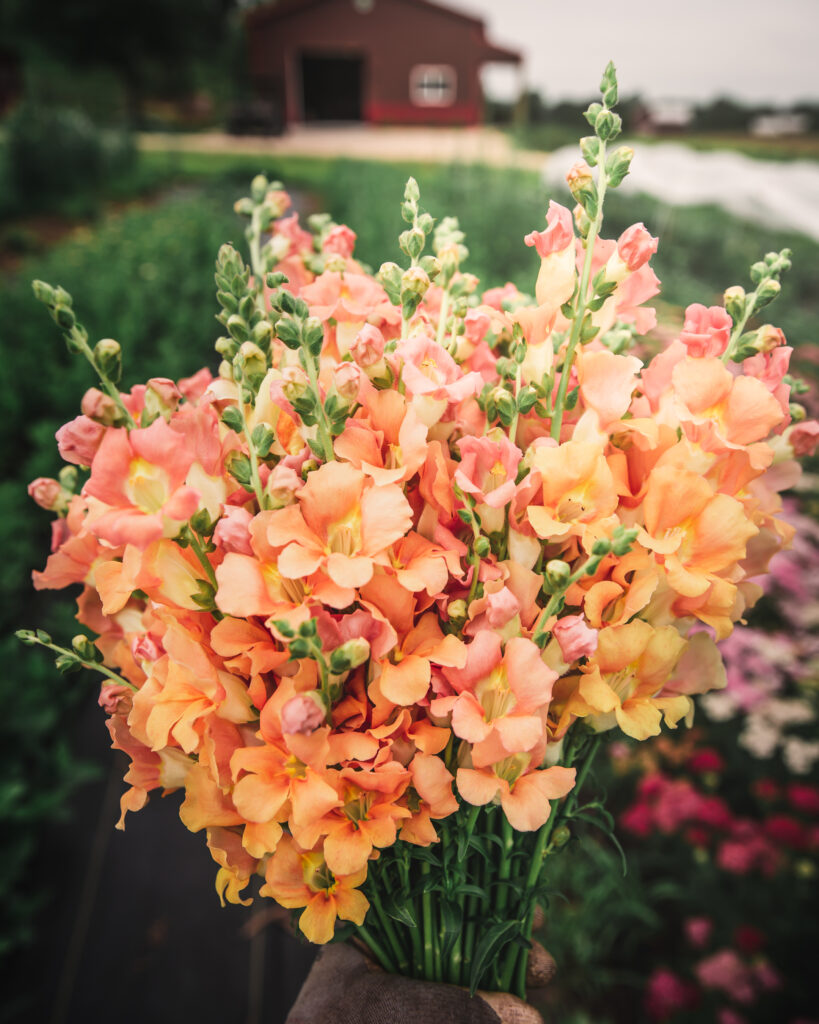

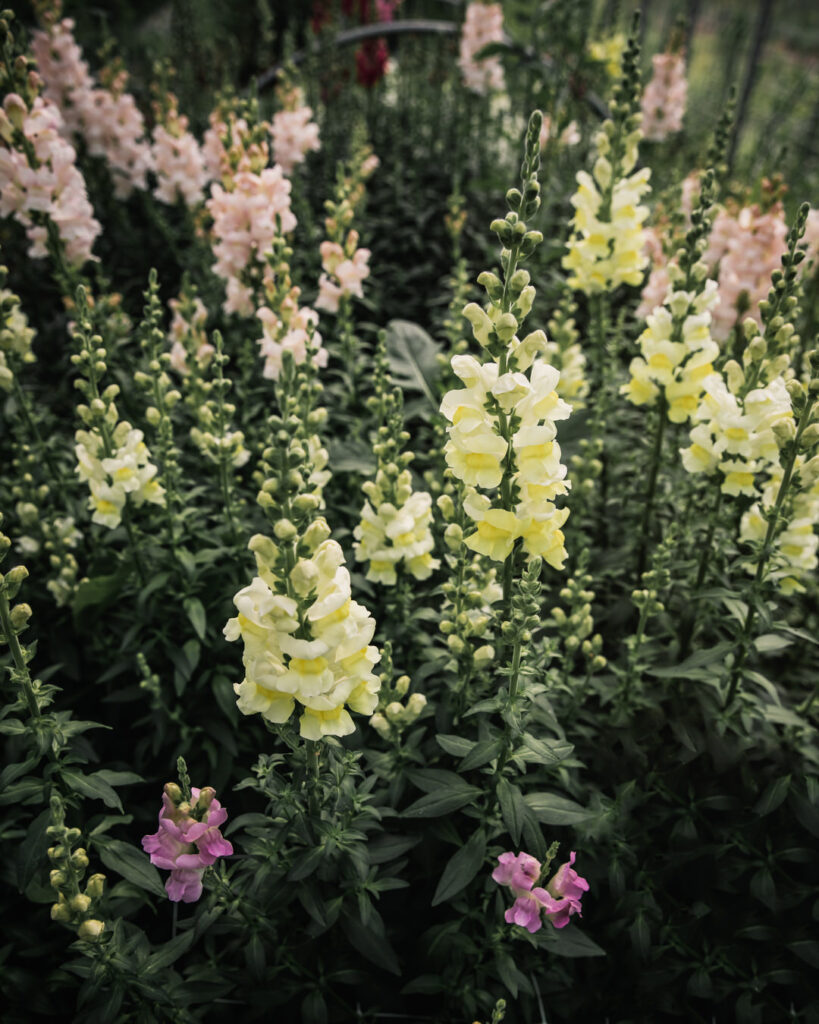
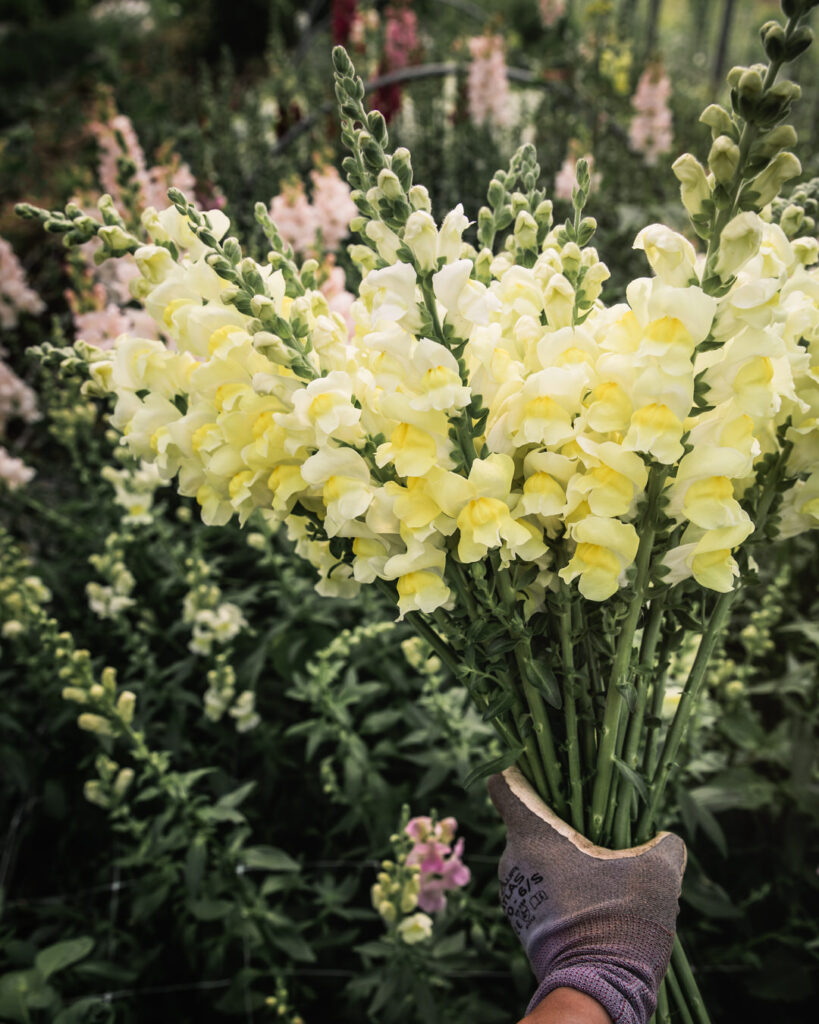
Pinching: N&B
USU notes that when plants have developed 5–6 nodes, they can be pinched back to 3–4 nodes to promote branching. Pinching can delay blooming but typically produces 5–8 marketable stems per season.
Non-pinched plants bloom earlier but yield just a single stem per plant. That first stem can be harvested at 2–3 nodes to encourage a second flush of stems about three weeks later.
Similarly, Dowling advises skipping pinching if your goal is more marketable stems, though he notes that pinching does boost overall yield. Bailey prefers not to pinch, resulting in taller stems with larger blooms. Johnny’s also points out that the single-stem approach delivers superior stem length and bloom quality.
Pinching: BTS
As I mentioned earlier, I used to pinch my snapdragons . . . but I’ve completely stopped. And honestly? I don’t miss it. Skipping the pinch has given me thicker, stronger stems, and I’d rather have that than more (but weaker) ones. Also, you can plant a ton of snapdragons in a small space (6-inch spacing, 3 plants per planting hole).
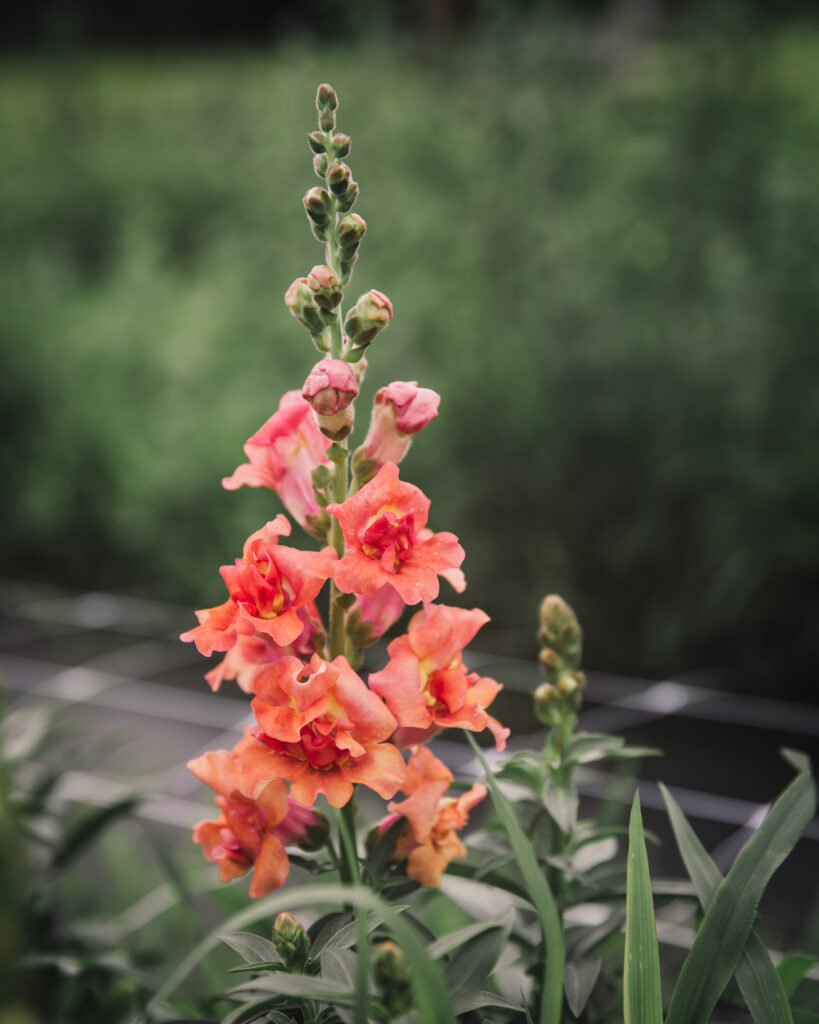
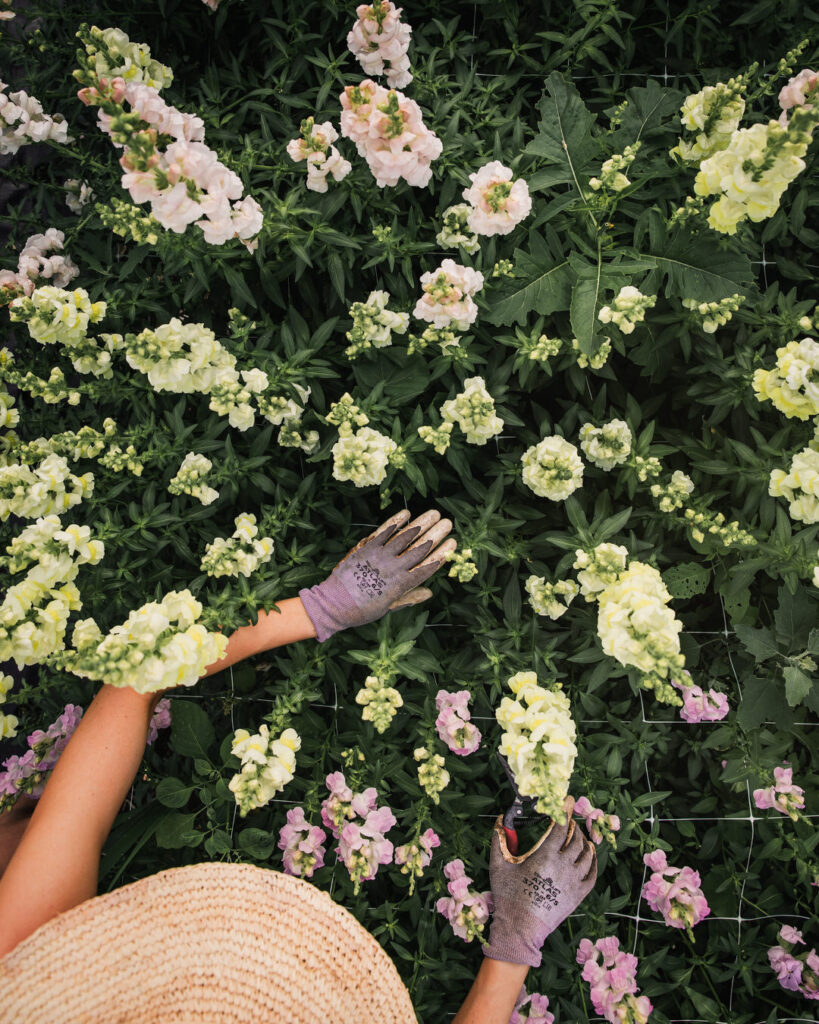

Bloom Period: N&B
Bloom period varies greatly depending on your location, growing environment, and whether you’re producing for fall or spring harvest. According to HortScience, selecting optimal transplant dates for your specific cultivar and environment—whether in a high tunnel or the field—can maximize marketable yields and extend the harvest window to about 4.5 months.
In a Tennessee field trial (USDA-ARS, Zone 7a), ‘Rocket Bronze’, ‘Rocket Pink’, and ‘Rocket White’ (Group IV) were transplanted on May 5 and began blooming in early June. Yields averaged 16–30 stems per plant (112–210 stems/m²) with stem lengths of 36–45 cm. Researchers often use 30–41 cm as the grading standard for marketable stems, though some, including the Society of American Florists, set the minimum at 46 cm.
In Indiana (Zone 5b), ‘Rocket Red’ (Group IV) was planted May 16–17 (one week after last frost), producing an average of 183 stems/m² with 51.8 cm stems in the high tunnel and 158 stems/m² with 39 cm stems in the field—showing the production and quality boost from high tunnel growing.
In North Dakota (Zones 3b–4a), ‘Rocket’ varieties and ‘Potomac White’ were planted as early as April 24—up to seven weeks before the last frost—and still performed well.
For warmer climates, like Zone 7/8, Ziegler recommends planting hardy annuals 6–8 weeks before first frost for overwintering, with first snapdragon harvests as early as April. In Johnny’s Zone 5a Maine trial, sowing on August 15, transplanting to the high tunnel on October 14, and harvesting May 19 proved a successful overwintering schedule.
Bloom Period: BTS
If we stick to a strict sowing schedule, there’s no reason we couldn’t have snapdragons all season long—from May through October. However, in practice, the bulk of our snapdragon bloom period falls in June through early August, since we tend to prioritize other crops later in the season.
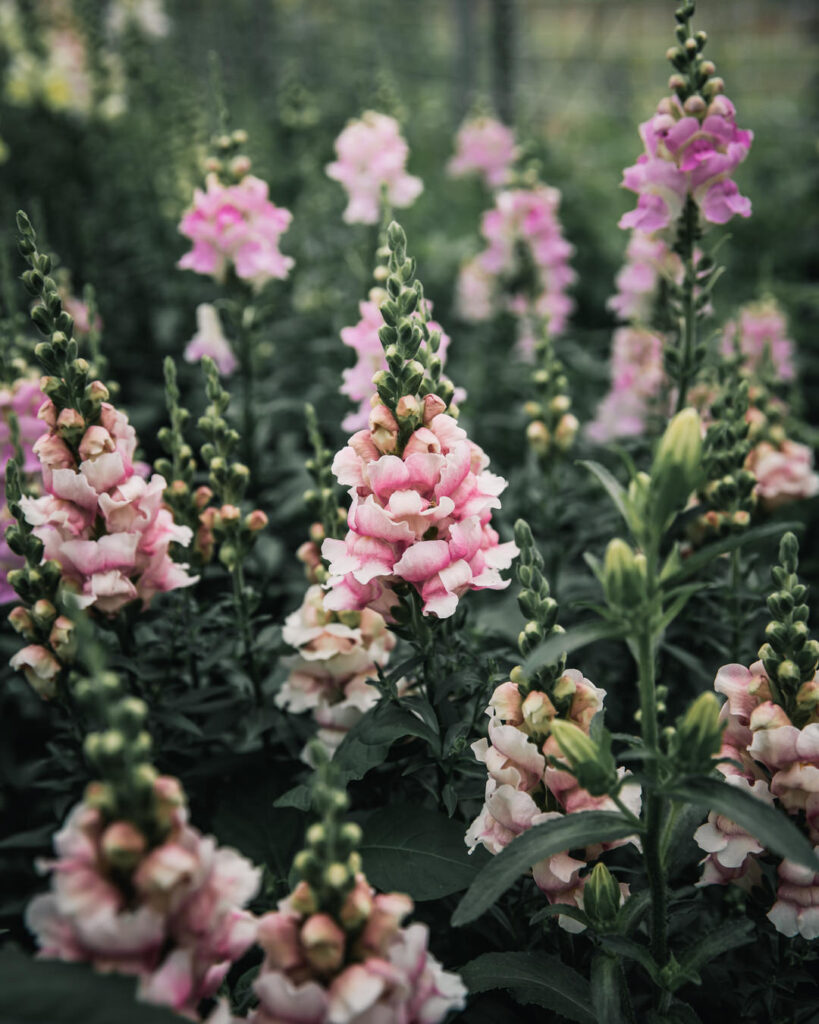
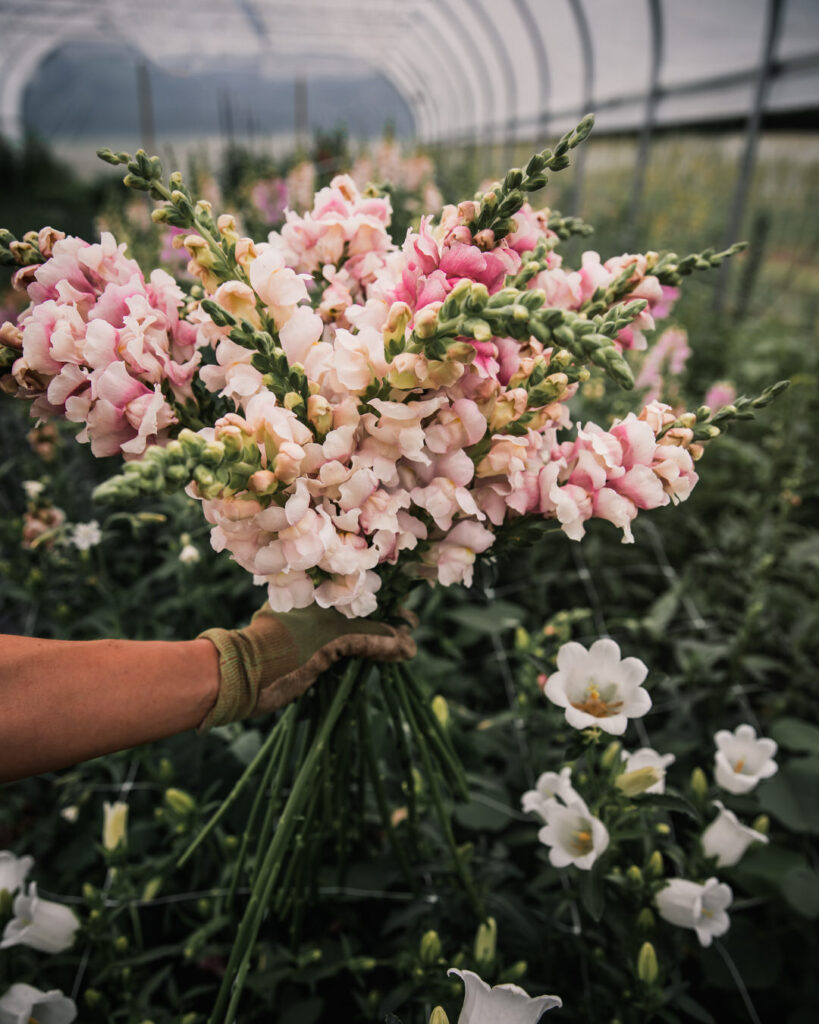
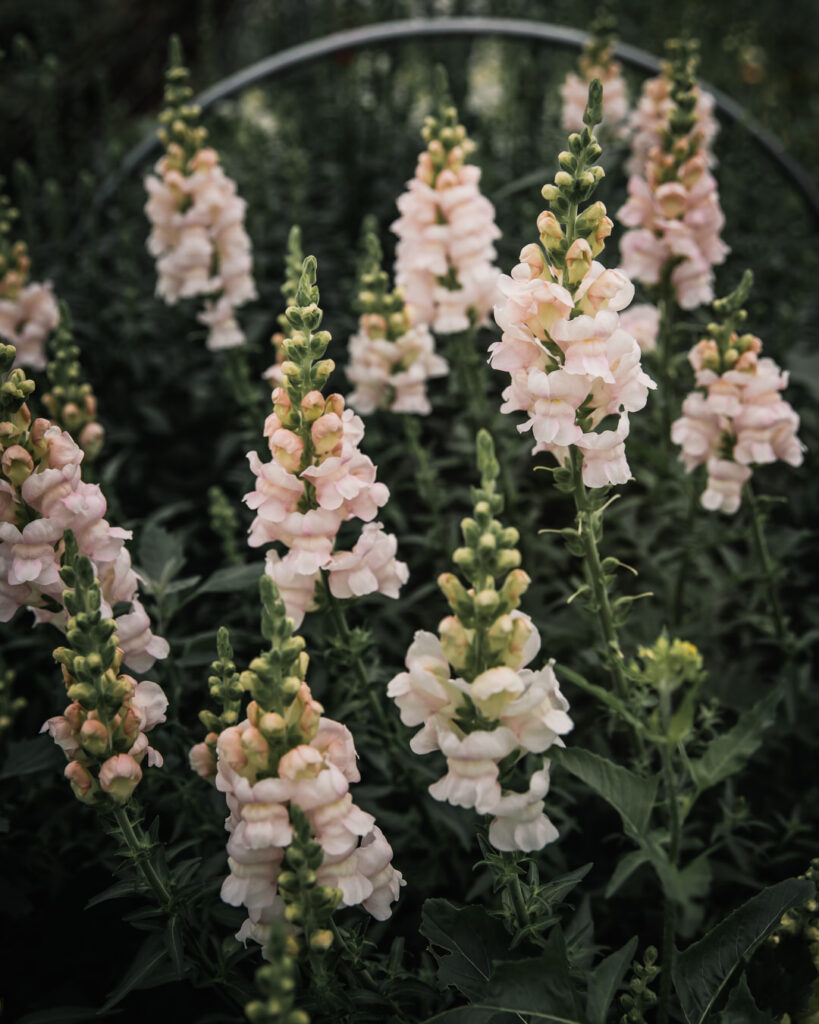
Additional Flushes: N&B
According to USU, allowing second flushes considerably adds to marketable yield:
When high tunnel marketability declined due to high temperatures in late July, plants were cut to a height of 3-5 nodes per stem and allowed to regrow in the cooler fall conditions. The second flush in the high tunnel occurred in late August to early September and increased total marketable yields for the season by 30–66%, depending on cultivar. ‘Chantilly’ and ‘Madame Butterfly’ were most productive in the second flush, as their groups (1-3) bloom under cooler temperatures and lower light.
While the second flush had less-marketable stems, it did extend harvest by 2 months with less labor and cost of a new planting (though potential yields of a second planting, whether snaps or another crop should be considered).
Additional Flushes: BTS
I don’t usually plan for a second flush, but if I don’t get around to flipping a bed, I’m certainly not going to turn down free flowers! Consider it an unplanned bonus bouquet courtesy of procrastination.
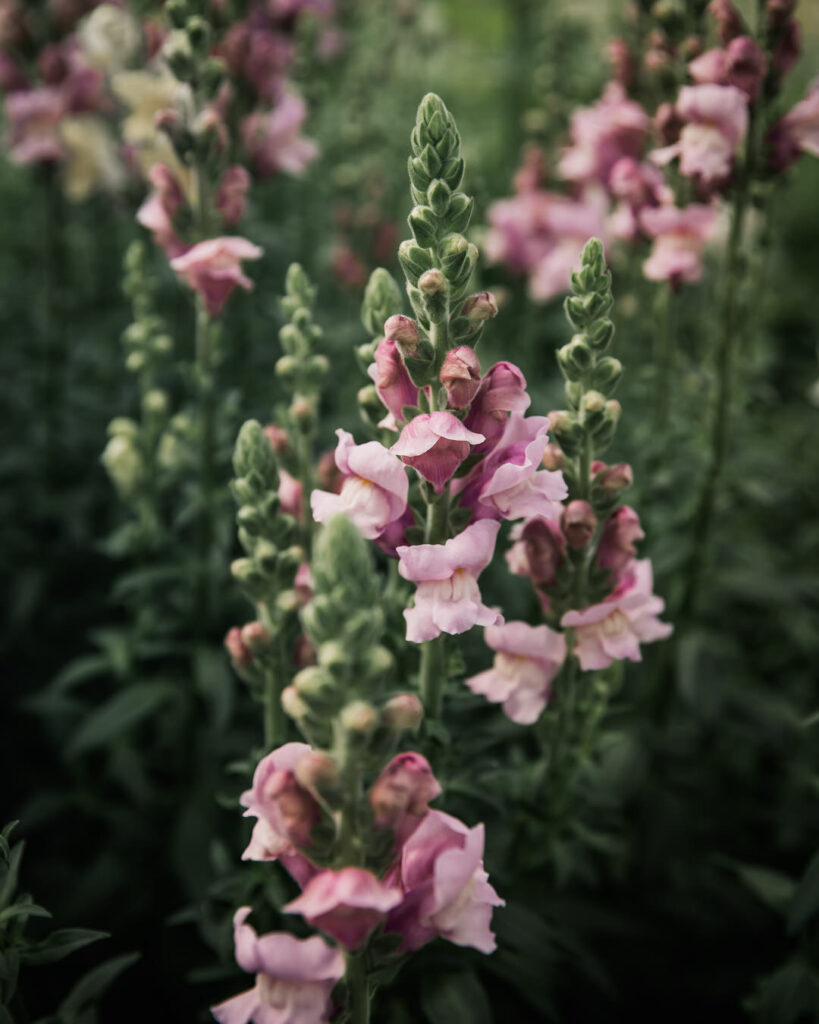
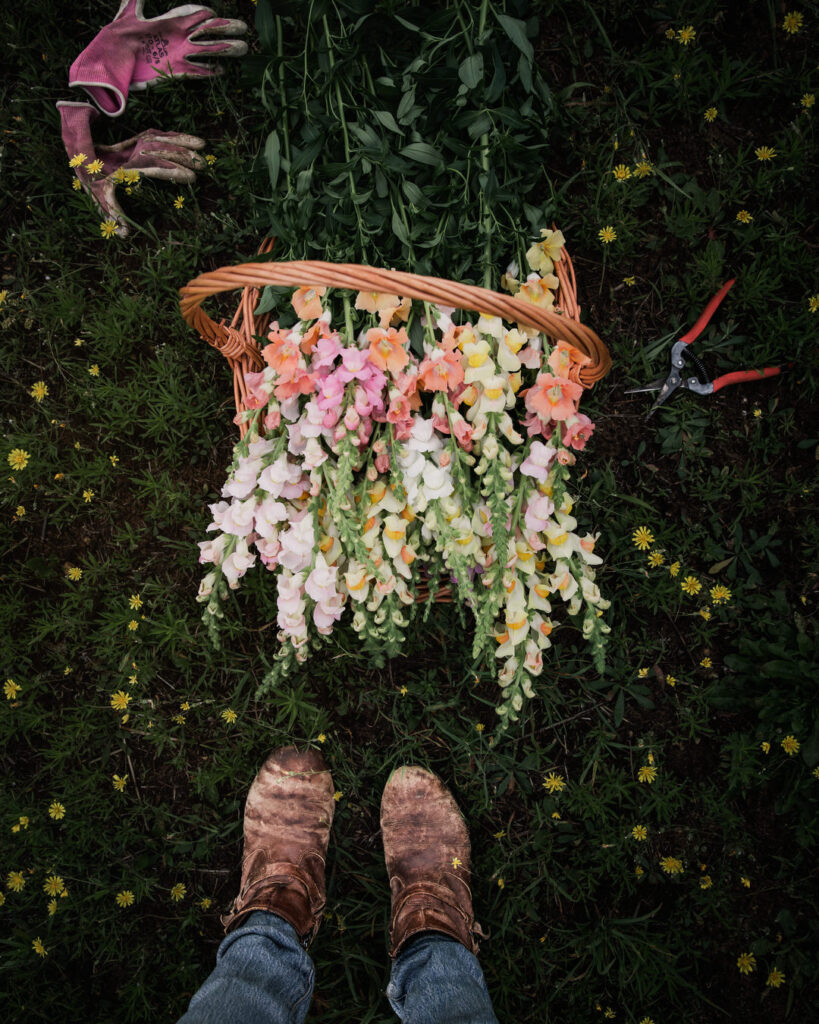
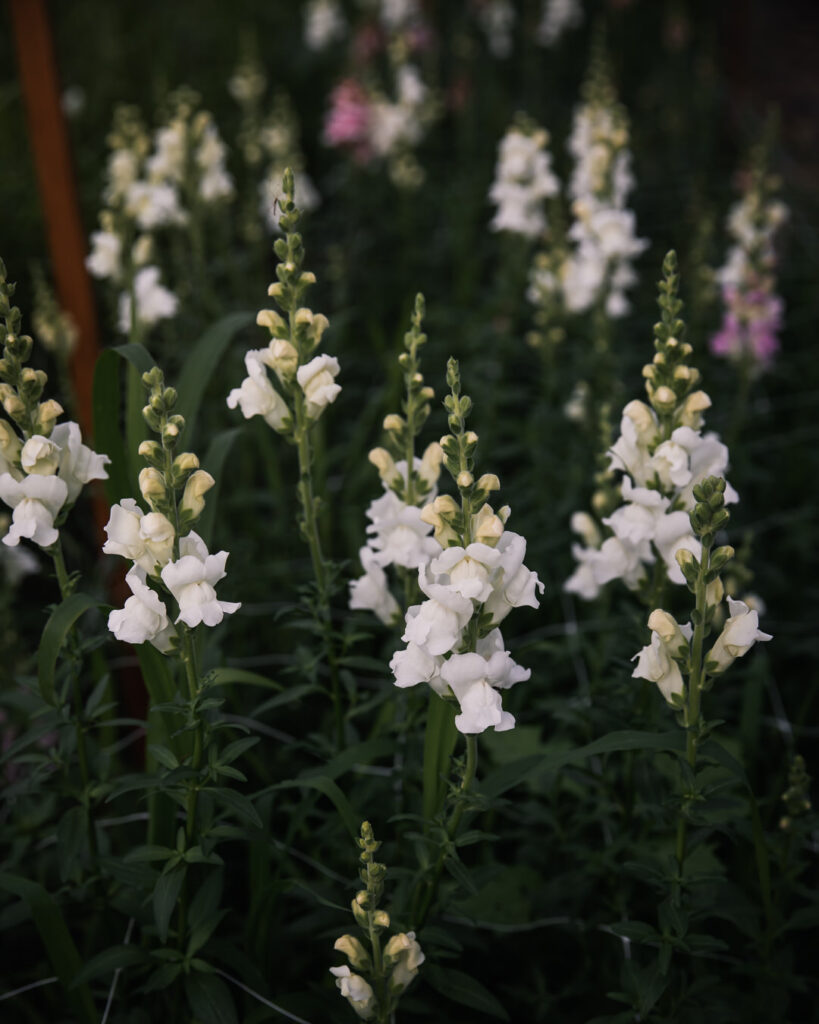
Overwintering: N&B
According to SCF, Zones 7–10 may overwinter in the field in areas where winters are sufficiently cold for flower production, but not so cold as to damage or destroy the plants. Similarly, Dowling notes that Zones 7 and warmer may be able to overwinter, with Zone 6 being able to overwinter with protection like a greenhouse or tunnel. Interestingly, overwinter trials at Johnny’s Selected Seeds in Zone 5a suggest we may be able to push this. In fact, their high-tunnel overwintered snapdragons had 100% survival rate (sowed on August 15, transplanted to the high tunnel October 14, and first harvest May 19). This is super exciting for those of us in colder zones!
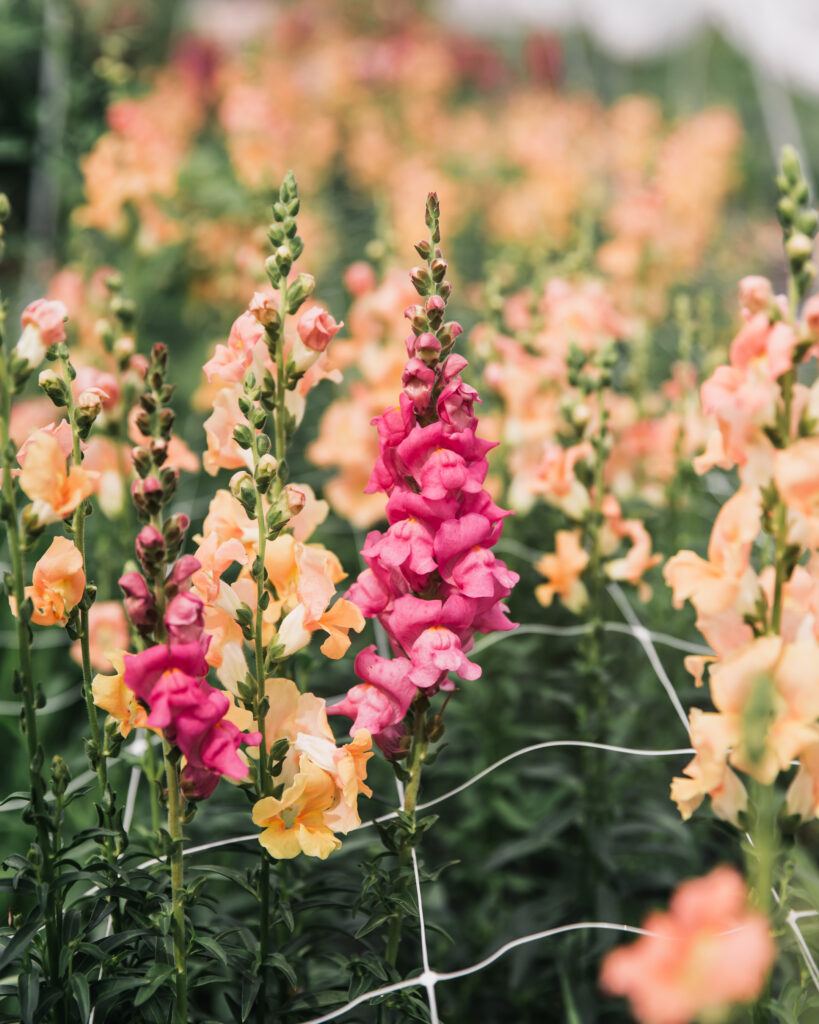
Harvest: N&B
Most sources recommend harvesting when 1/3 to 1/2 of the flowers are open, and immediately placing stems into a holding solution. Postharvest Handling notes that if stems need to be stored, cut earlier—when only 2–3 lower buds are expanding or just showing color. NC State trials found that stems harvested at this earlier stage had a longer vase life than those cut with more open flowers, though they were less showy.
Dowling offers a slightly different perspective: while the early cut can extend storage life, snapdragons are ethylene sensitive, so it’s often better to wait until flowers are a bit more open, especially if they’ll be used right away. He also points out a very real challenge—bees. If pollinators get to the blooms, the petals will drop, so earlier harvests can help avoid that problem.
According to Postharvest Handling, fresh stems last 7–10 days in water and 12–15 days in preservative.
Harvest: BTS
We stick to the general rule—harvest when 1/3 to 1/2 of the flowers are open—but I’ll take them a little more open if the situation calls for it. And yes, we try to “beat the bees” but I’m also OK with sharing.

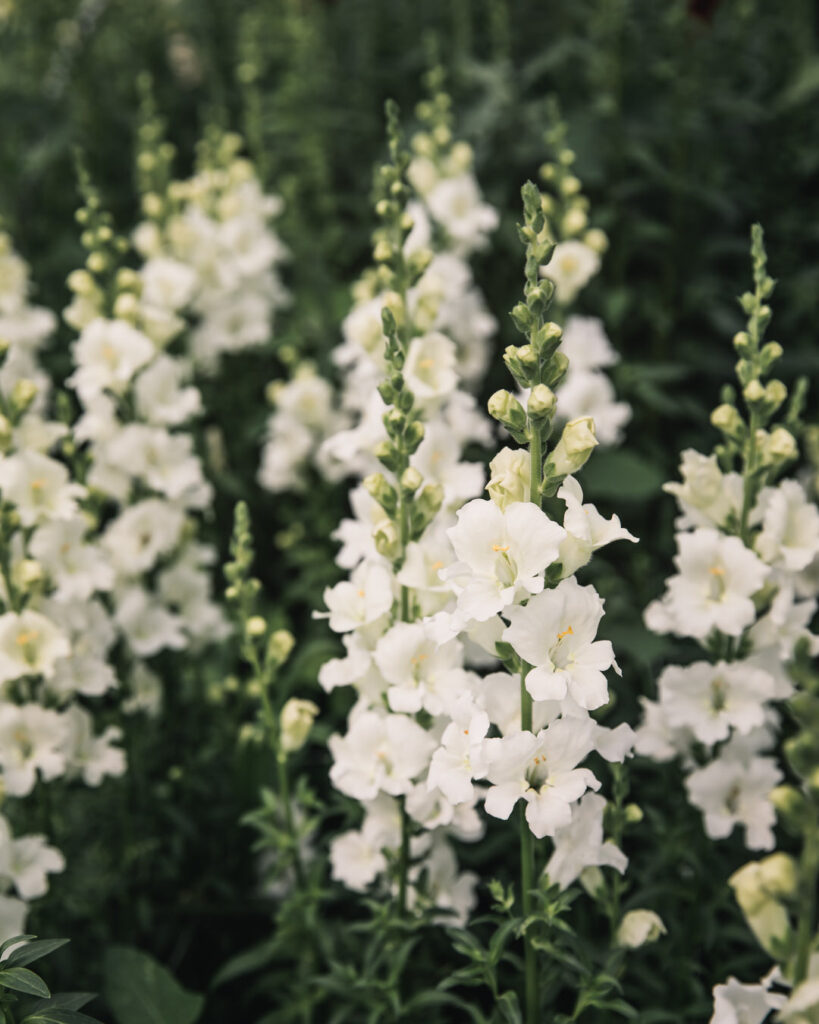
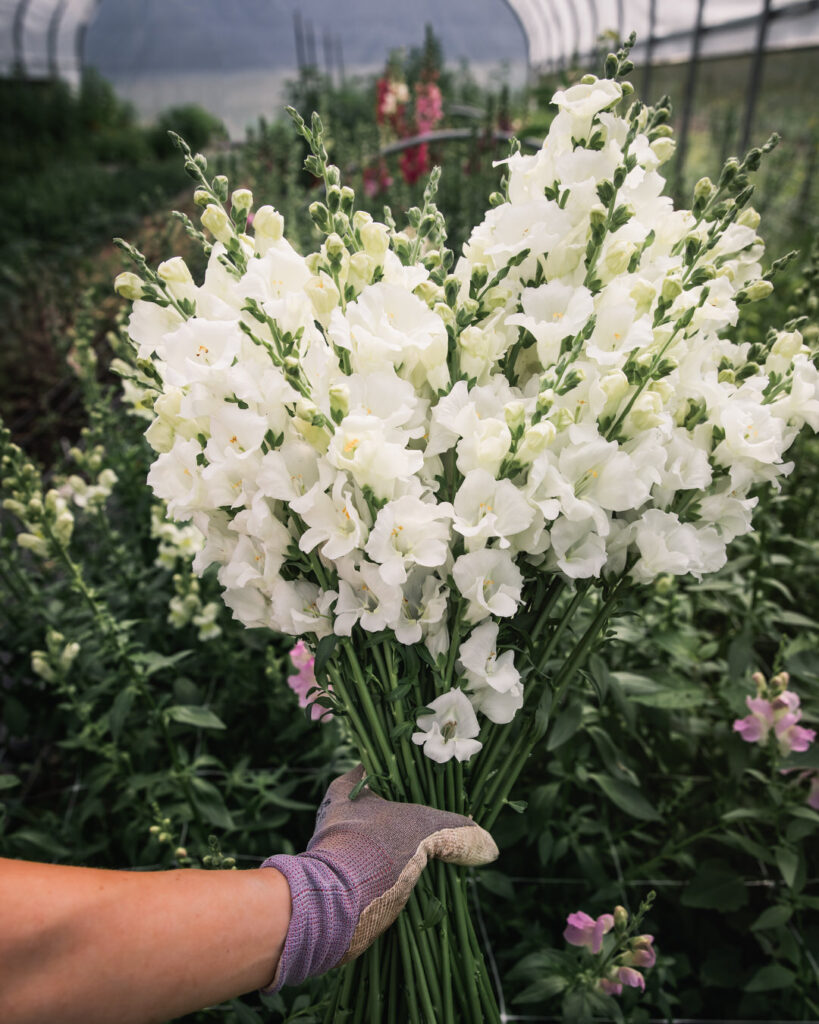
Post-Harvest Treatment and Storage: N&B
Most sources recommend harvesting directly into a holding solution. Because snapdragons are geotropic—meaning they respond to gravity—all sources stress the importance of keeping them upright after harvest. If stems are allowed to rest at an angle or splay in a bucket, the spikes will curve upward, and once that bend sets, it can’t be straightened. Dowling and Ziegler both recommend using tall buckets and packing them tightly enough to keep stems vertical—think 5-gallon bucket style.
According to Postharvest Handling, stems can be stored either wet or dry at 40°F (4°C) for 5–7 days. Interestingly, NC State trials found that dry storage extended vase life compared to wet storage. They also note that stems can be stored for 10–14 days at 38–40°F (3–4°C). If storing dry, rehydrate in a bud-opening solution at 70°F (21°C), >80% relative humidity, and with 16 hours of light per day.
Post-Harvest Treatment and Storage: BTS
We harvest our snaps straight into holding solution and keep them in the cooler at around 38°F. I’ve never tried dry storage, but the NC State findings make me curious—it might be worth a test. As for keeping them upright, I use tall buckets when I have them, but if space or supplies are tight, I’ll lean bunches carefully against the cooler wall to keep those stems straight.
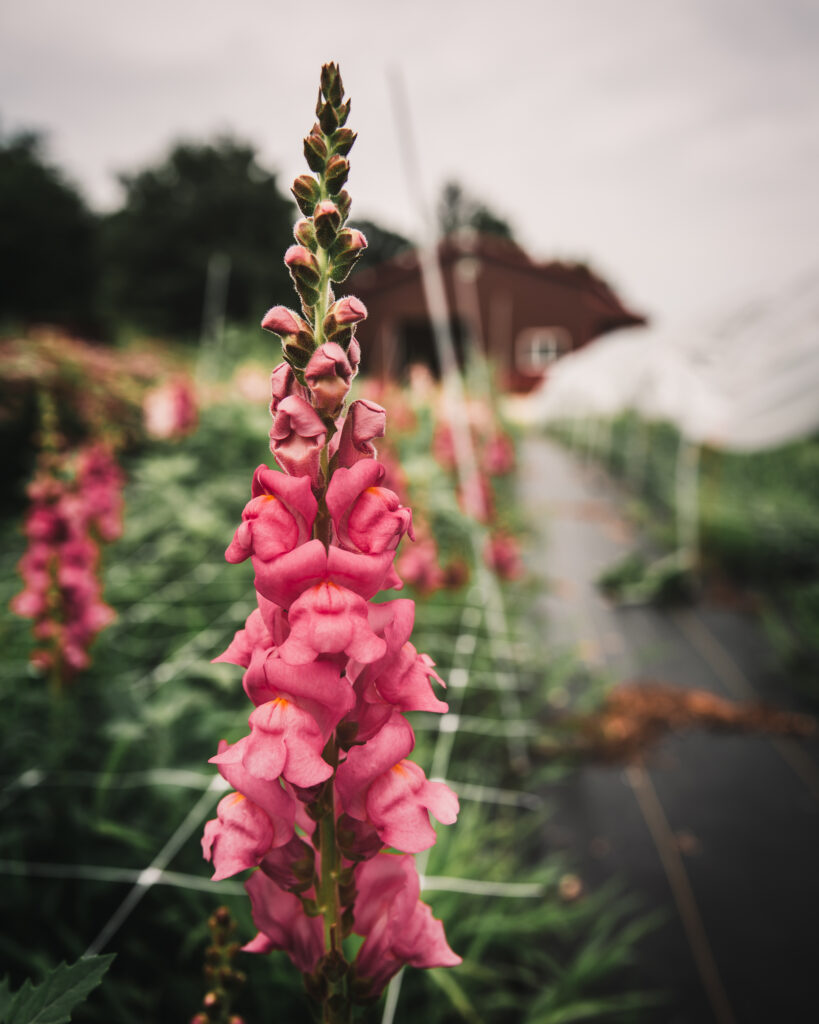
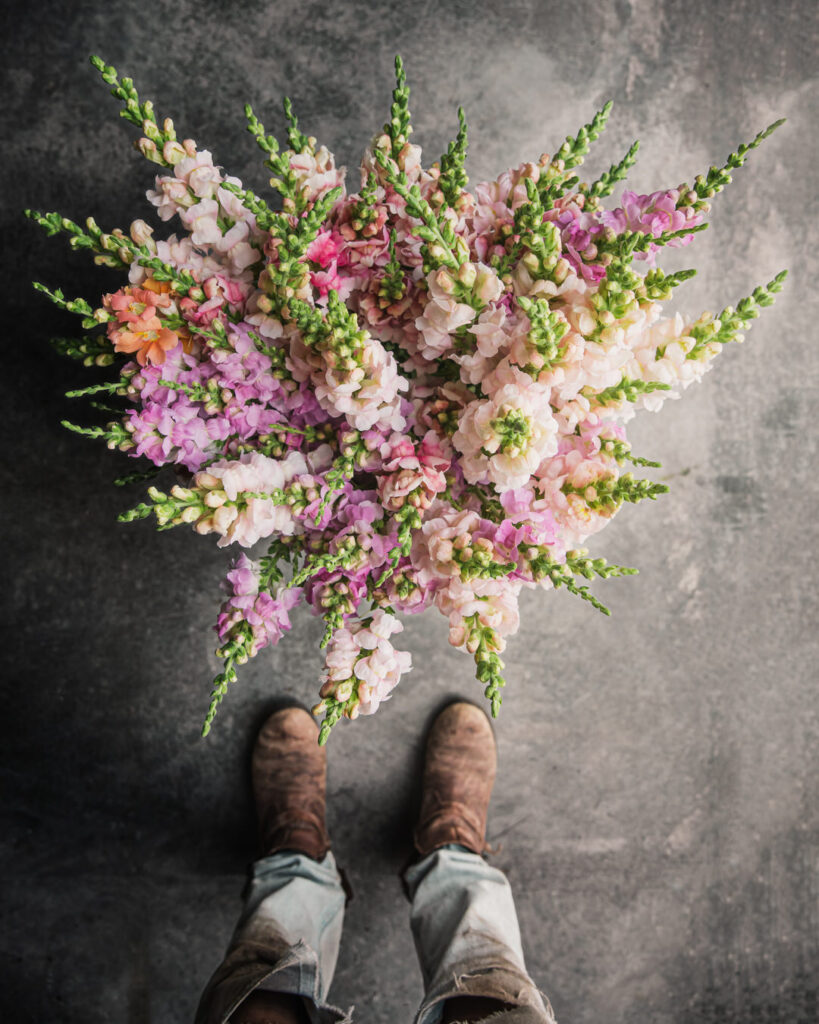
Pests & Disease: N&B
According to SCF and Johnny’s, the most serious and common disease in snapdragons is rust, caused by the species-specific fungal pathogen Puccinia antirrhini. Rust typically appears as a buildup of dark-brown to purple spores on stems and leaves, but Johnny’s notes that the most reliable way to confirm a diagnosis is to send a sample to your local Cooperative Extension service or another agricultural research station.
Snapdragons are also prone to botrytis (gray mold) as well as powdery and downy mildews. On the pest side, the most frequent offenders are aphids and thrips, which can cause both cosmetic and structural damage to blooms and stems. Practice crop rotation to reduce the buildup of soilborne pathogens and pests.
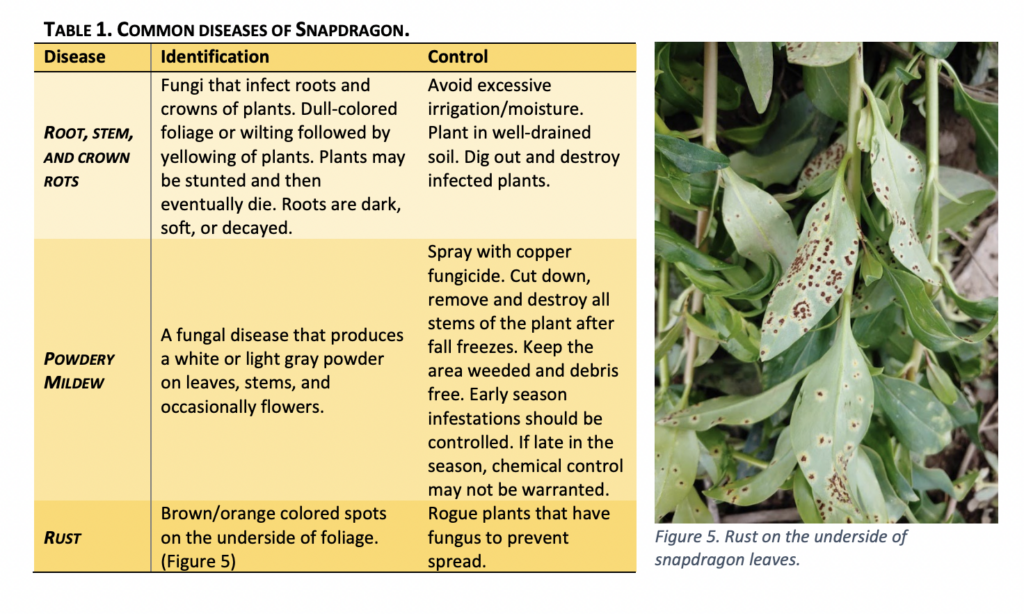
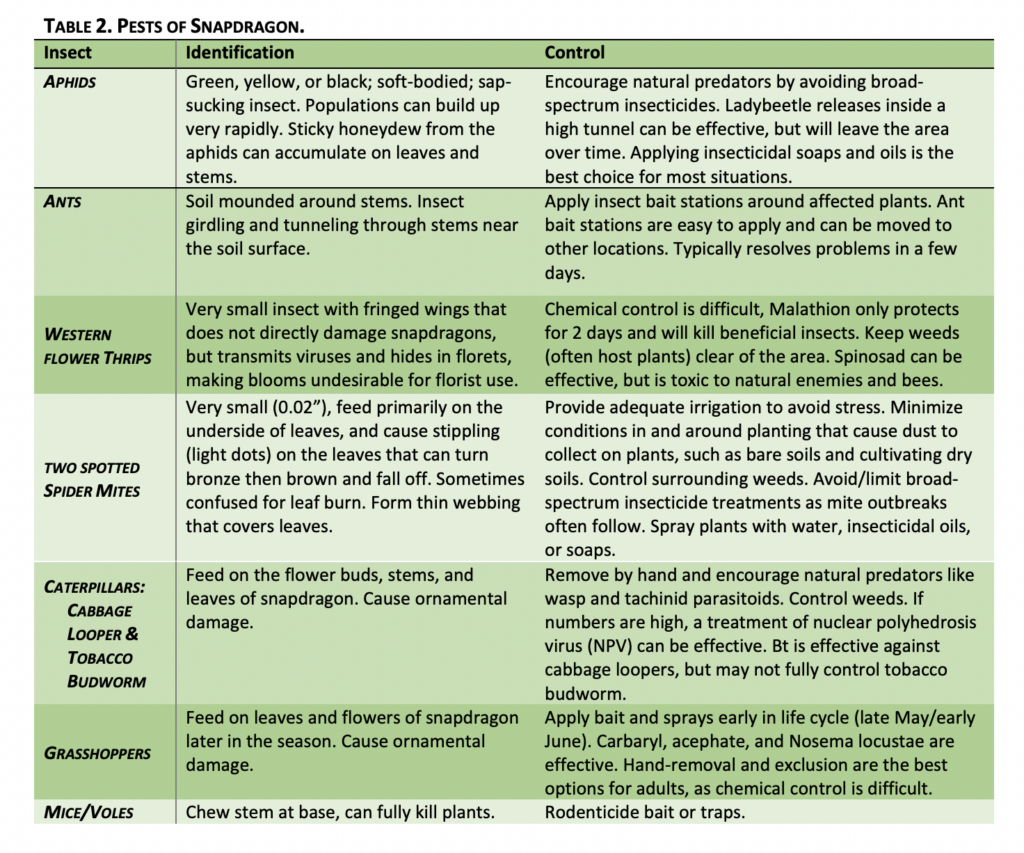
Pests & Disease: BTS
We rarely run into pest or disease issues with snaps, which is one of the reasons I love growing them. That said, in 2023 we had a minor run-in with thrips in the high tunnel. Since then, we’ve added a little “good bug army” to our IPM strategy—introducing beneficial insects like lacewings and ladybugs, which also help keep aphids in check. I still spot lacewings in our tunnel regularly, which is a good sign they’ve settled in and are doing their job.
We also rotate our crops to help prevent pest and disease buildup in the soil. While we haven’t faced any major snapdragon issues, I always recommend keeping Johnny’s Pest and Disease Management Chart handy—it’s a great resource if something unexpected pops up.
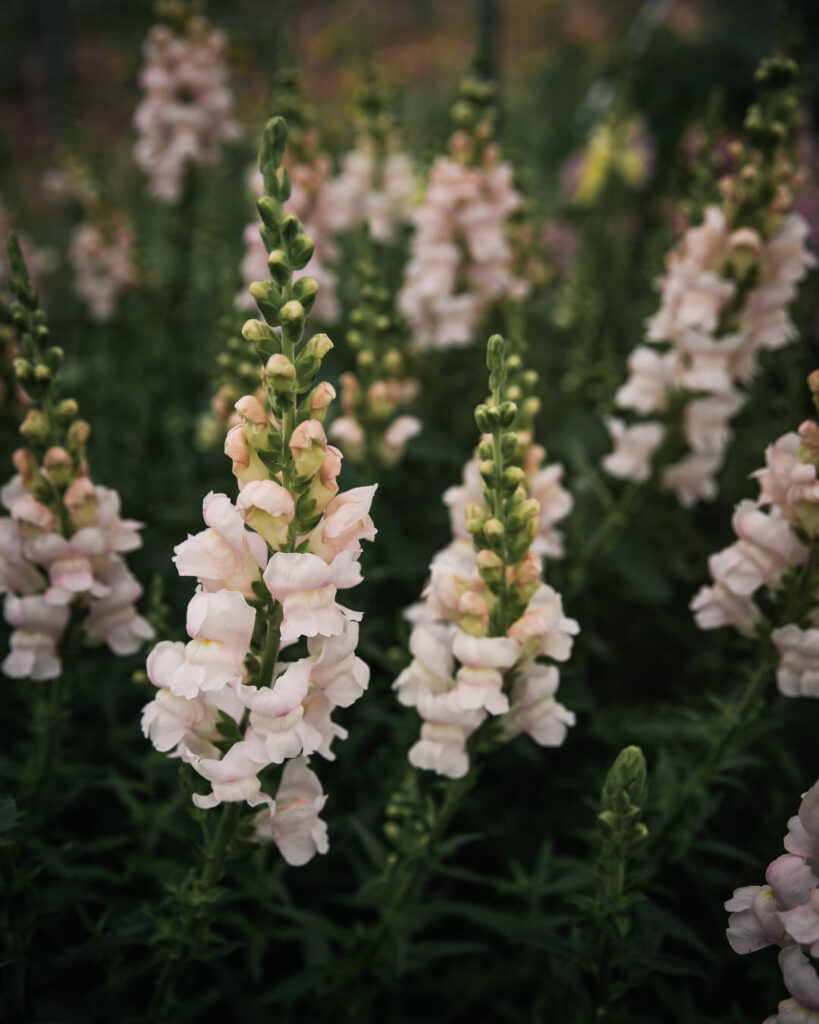
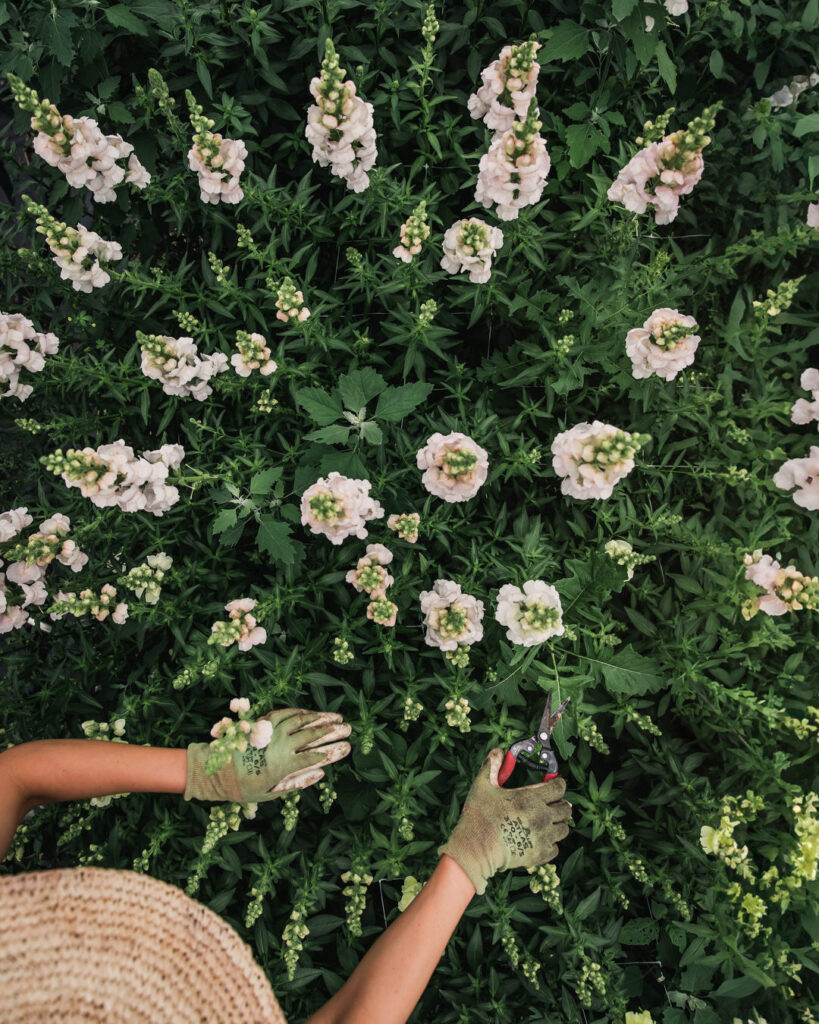
Variety Selection: N&B
Most sources seem to recommend many of the same series: Costa, Chantilly, Butterfly, Potomac, Rocket, Opus, with Dowling and SCF also mentioning Maryland and Johnny’s noting Bridal Pink and Legend Light Pink as performing well in their overwinter trial for early spring snaps.
Variety Selection: BTS
There are so many amazing snapdragon varieties out there, but when it comes to snapdragons as cut flowers, be sure to choose the right ones! Choose snapdragon varieties specifically bred for cut flower production. Most seed catalogs note this, but a good thing to always check is their mature height. Some snapdragons are bred for containers and will only grow 8″ tall no matter how well you grow them! For snapdragons, I’m looking for 20″ plus, though some grow almost as tall as me!
PBF Favorites
- Avignon/Costa Apricot
- Avignon/Costa Silver
- Bridal Pink
- Cannes Orange
- Chantilly Light Salmon
- Chantilly White
- Legend Light Pink
- Madame Butterfly Bronze
- Madame Butterfly Cherry Bronze
- Maryland Rose
- Orleans Early Lemon Yellow
- Potomac Appleblossom
- Potomac Lavender
I was so excited to grow ‘Double Frappe Light Pink’ this season—like, counting-down-the-days excited. But somehow, it got missed from our wholesale order, and by the time I realized, it was already out of stock. UGH. It happens. The silver lining? I’ve already talked with our wholesaler, and they’re hopeful it’ll be available for us next season. It should also be in stock for our next seed sale, so fingers crossed we’ll all be growing it soon.
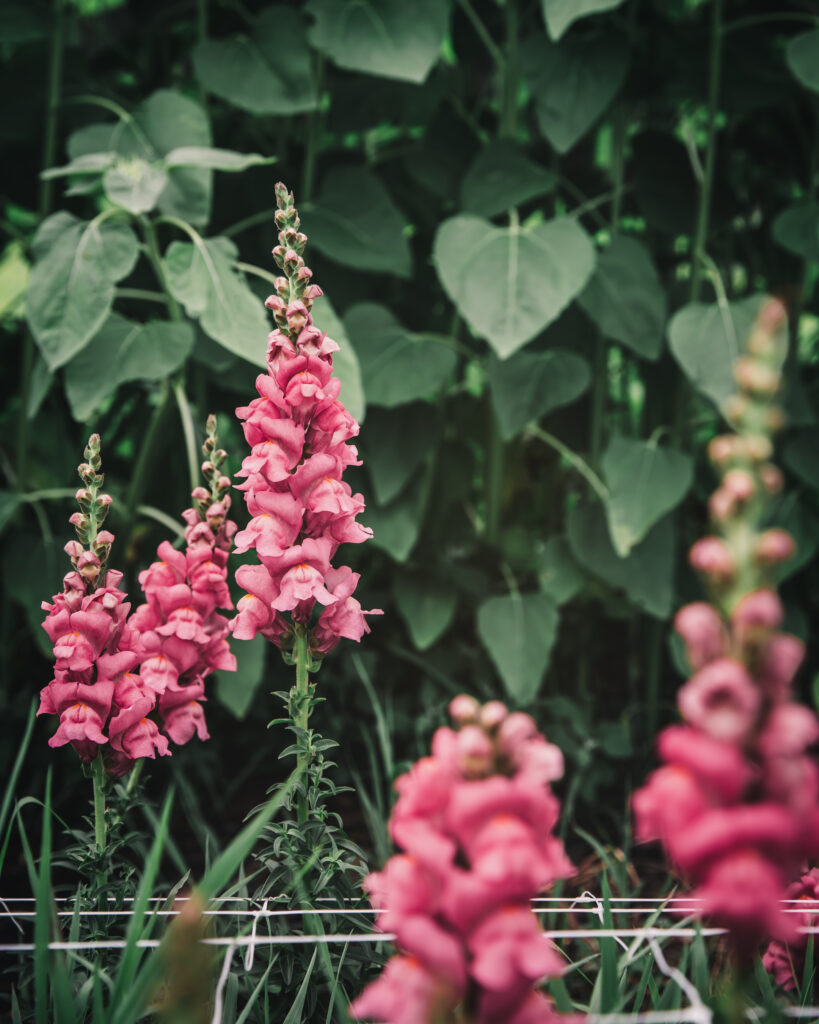

Pricing: N&B
BOSTON Ornamental Terminal Prices as of 11-APR-2023:
SNAPDRAGON: MARKET STEADY. bunched 10s CD long 15.00-18.50 mostly 15.00 med
12.50-13.50 mostly 13.50 NENG long 18.00
Typically, wholesale markets grade snapdragons and price them accordingly. I’ve seen a wide range of prices, from $8–$20+.
HortScience reports different findings locally (though these would be considered retail):
…local markets did not support price variation by marketable grade. Regardless of marketable stem length, bunches of five consistently sold for $7.50, the equivalent of the maximum wholesale price for long to extralong stems (USDA Agricultural Marketing Service, 2019), indicating a strong and consistent market demand for local production and more relaxed standards for quality based on stem length. However, sellers and florists also showed preference for stem lengths between 60 and 76 cm, which were less prone to breakage during storage, transport, and floral arranging, and stems that were stored upright to prevent curvature. Therefore, continued, local production of stems that are 60 cm or longer, which can be trimmed to the marketable length and are minimally curved, can supply a niche market in high demand.
According to USU, “Snapdragons are a florist staple and are consistently in demand due to their tall upright blossoms, long vase life, and strong stems. Wholesale snapdragons are easily damaged during shipping and storage. Therefore, high-quality, locally grown snapdragons that are longer than 18 inches and a popular color are in strong demand. The wholesale price for snapdragons ranges from $1.20-$1.30 per stem. USU trial snapdragons in bunches of 5 sold for $6.00 ($1.20 per stem) in the Cache Valley and Wasatch Front markets.”
Pricing: BTS
We don’t sell snaps retail, but our florist price would be $12 / 10 stems.
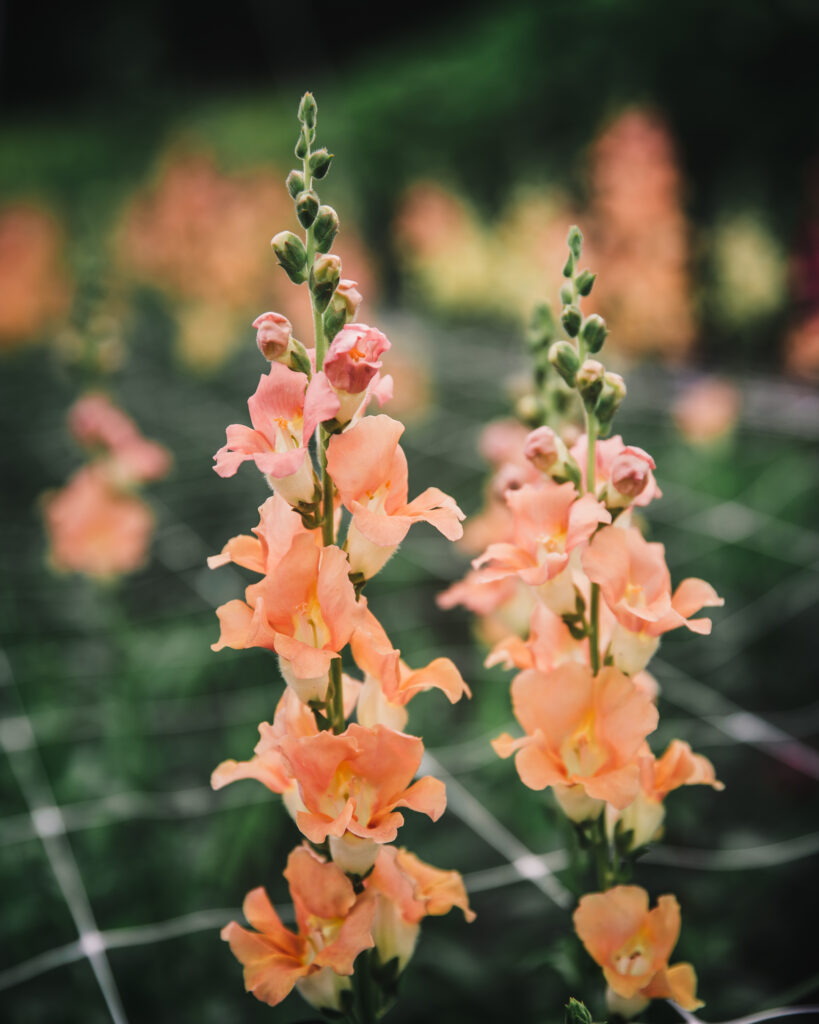
Wrap Up
And there you have it—our deep dive into snapdragons is officially in the books! 📚 So, what do you think—did you find a few golden nuggets? Learn something that’ll change your growing game? Or are you just feeling really, really ready to grow these beauties?
Remember, you don’t have to memorize it all: Use the buttons below to print a copy or save this as a PDF so you can revisit anytime. And don’t forget the magic trick: Ctrl+F (PC) or Command+F (Mac) to find exactly what you need in seconds.
Now, I’d love to hear from you. Got a burning question? An aha moment? Or a hack you swear by? Drop it in the comments below! This is where the collective magic happens. I’m a big believer in the power of the collective: your insight could save someone else’s season (and vice versa).
Alright, my friend—go forth, plant boldly, and may your plants be lush, healthy, and just a little bit extra. 🌱✨
Cheers, pal!✌️
Maggie
cLICK FOR Comments +